Cottage dining rooms blend easygoing charm with thoughtful detail, creating spaces where meals become lingering moments and every layer tells a story of comfort. Design outlets agree that the look thrives on vintage character, tactile surfaces, borrowed-from-nature palettes, and pieces that feel lovingly collected rather than bought in a single trip. Whether you favor coastal airiness, English-country romance, or farmhouse utility, the twenty-five ideas below walk you through practical ways to weave each mood into a dining nook or full-size room — always keeping coziness, budget-friendliness, and personality top of mind. Pull up a chair and let inspiration settle in.
1. Weathered Wood Table to Anchor Your Cottage Dining Room
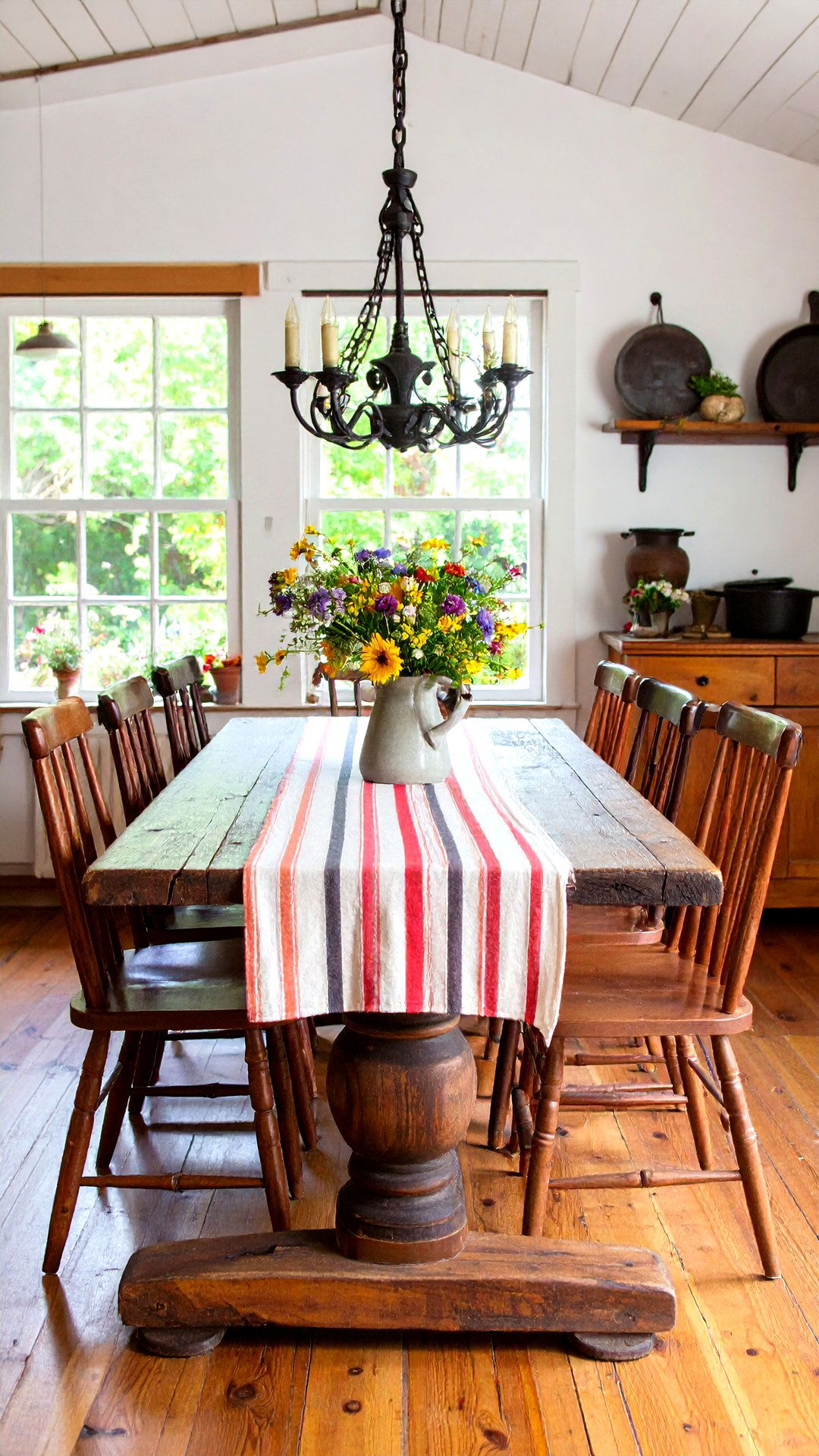
A timeworn pine or oak table immediately signals relaxed hospitality, grounding the cottage dining room in organic warmth. House & Home notes that oversized trestles or chunky pedestal bases evoke lake-house weekends where everyone crowds around for pancakes and stories. Pair a salvaged tabletop with mismatched chairs to soften formality; the patina hides scuffs, so kids and pets aren’t off-limits. Layer a striped linen runner for texture, then top with wildflowers in a stoneware jug for an unfussy centerpiece. The sturdy silhouette also supports heavy cast-iron cookware when buffet service replaces plated meals — proving beauty and function can happily coexist.
2. Mix-and-Match Vintage Chairs for Character in the Cottage Dining Room
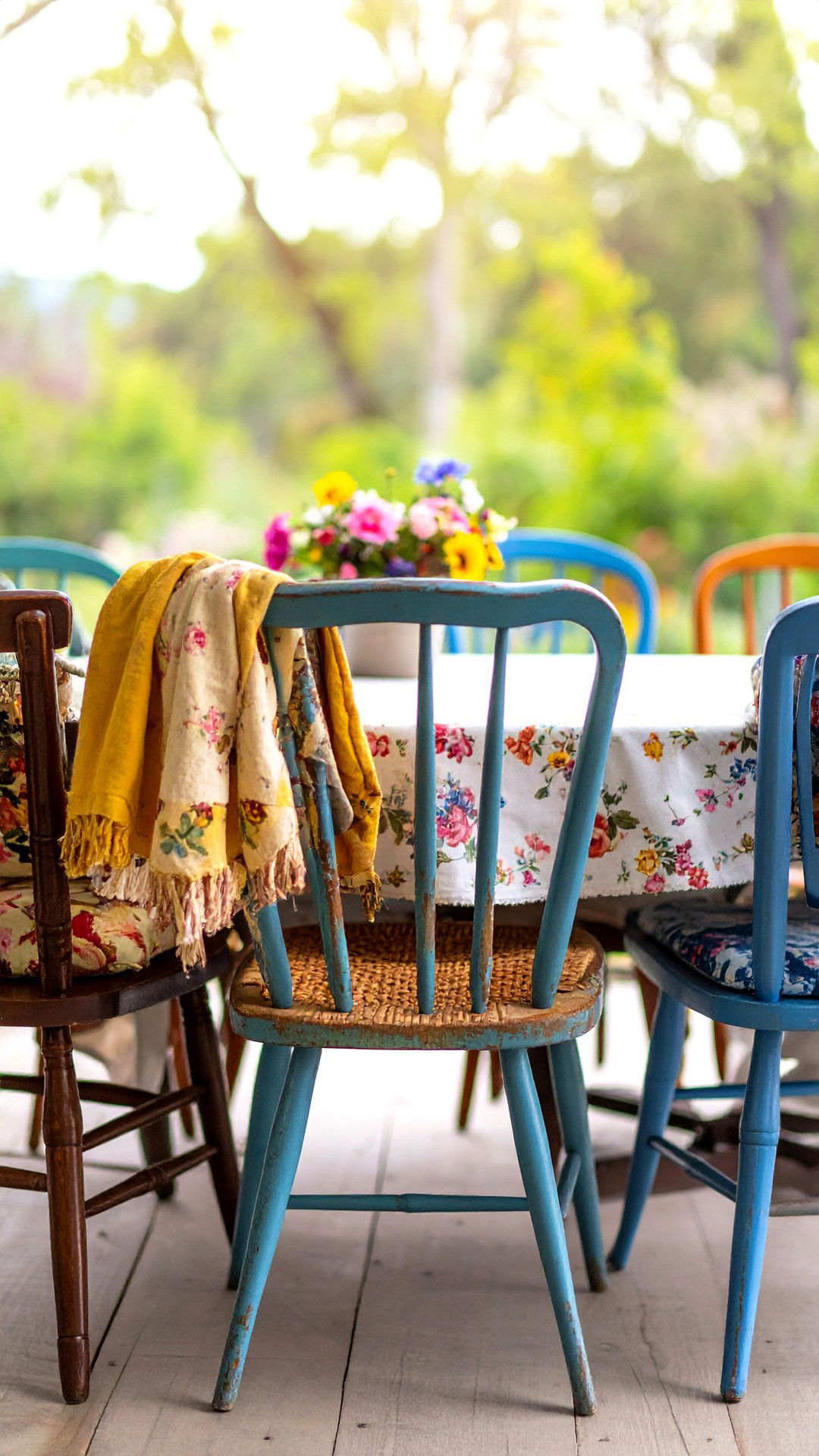
Unlike sets that scream showroom, a collected row of spindle-back, cane-seat, or painted Windsor chairs instantly breathes life into a cottage dining room. Country Living highlights how swapping uniformity for individuality brings stories to the table, whether a flea-market rocker or Grandma’s maple side chair. Keep cohesion by repeating one common thread — maybe all chairs share a whitewash finish or seat cushion fabric. Slip a lightweight throw over one backrest for tactile depth. Besides charm, eclectic seating lets hosts pull in extra perches from elsewhere, making spontaneous gatherings feel intentional rather than overcrowded.
3. Soft Pastel Florals Refresh Your Cottage Dining Room Palette
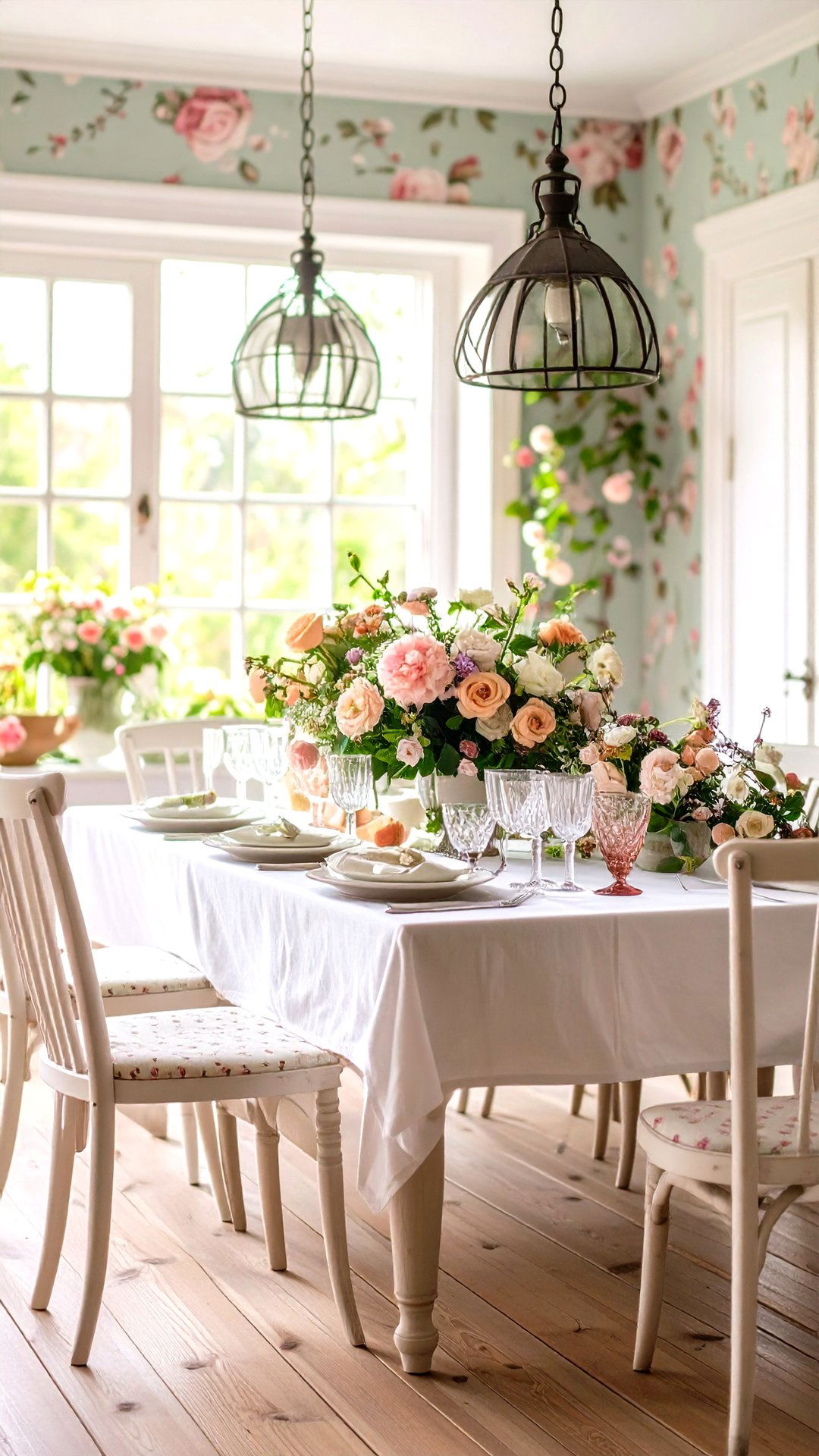
Gentle sage, blush, and buttercream florals whisper springtime year-round, offering an antidote to all-white spaces. Better Homes & Gardens explains that English-rose wallpaper or ditsy-print seat pads introduce romantic nostalgia without overwhelming small rooms. Balance sweetness with raw wood floors or iron lighting, ensuring the cottage dining room feels layered, not saccharine. When budget forbids new paper, try floral table linens paired with neutral walls; the removable fabric lets you change motifs seasonally. Finish with vintage glassware that catches afternoon light in subtle pastel reflections — proof that restrained color can still spark joy.
4. Built-In Banquette Seating Maximizes a Cottage Dining Room Nook
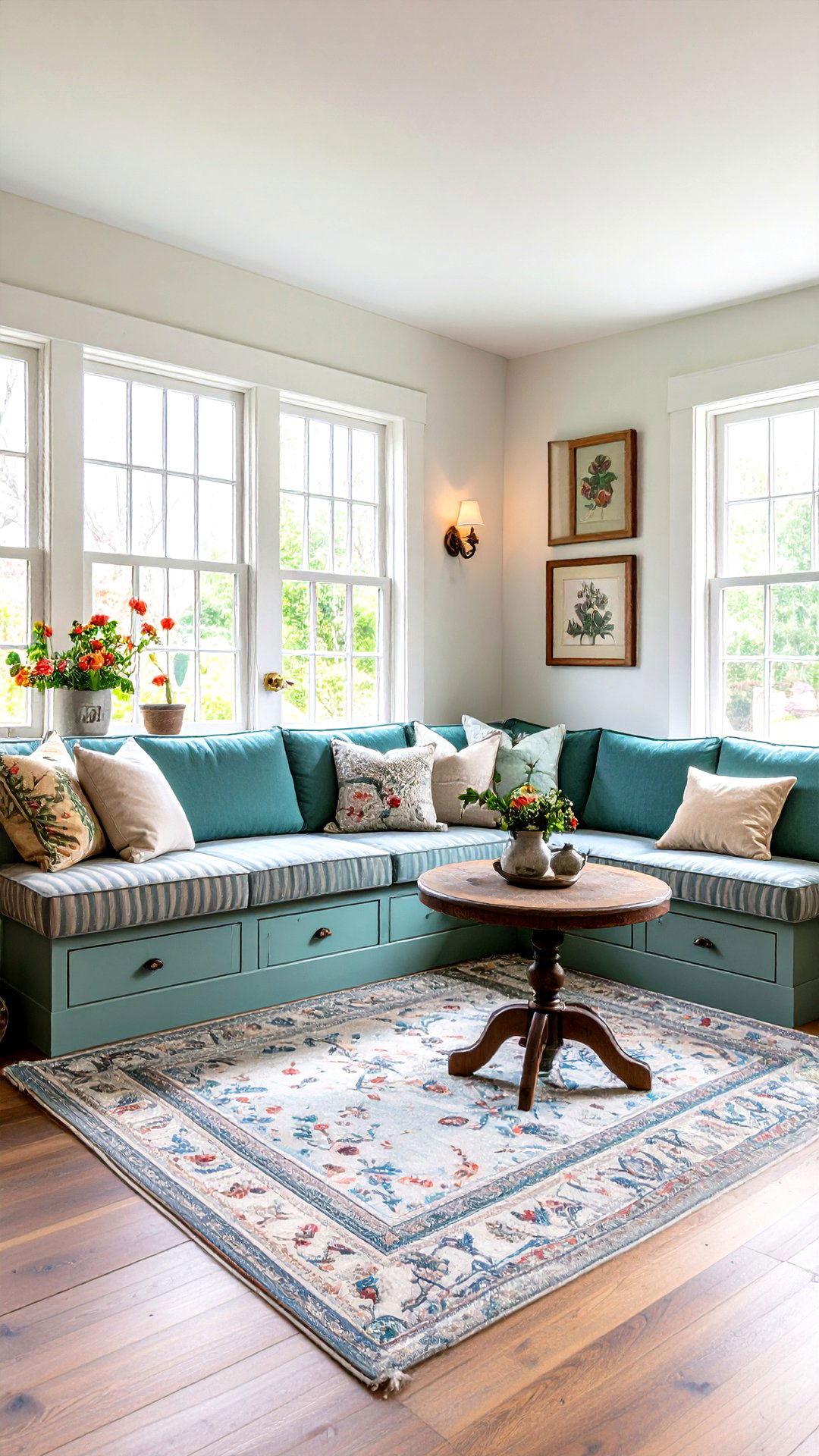
For tight cottages where square footage is precious, Real Homes suggests framing a corner banquette beneath cottage-pane windows. Bench bases can hide deep drawers for table linens, while plush cushions invite lingering over tea. Upholster in washable ticking stripe to stand up to spills, and anchor the layout with a petite pedestal table that scoots for easy access. Sconces above free up tabletop real estate, and a gallery of botanical prints turns the backrest wall into art. The result feels custom yet attainable, offering storage, comfort, and architectural interest in one cozy swoop.
5. Open Shelving for Display-Ready China in the Cottage Dining Room
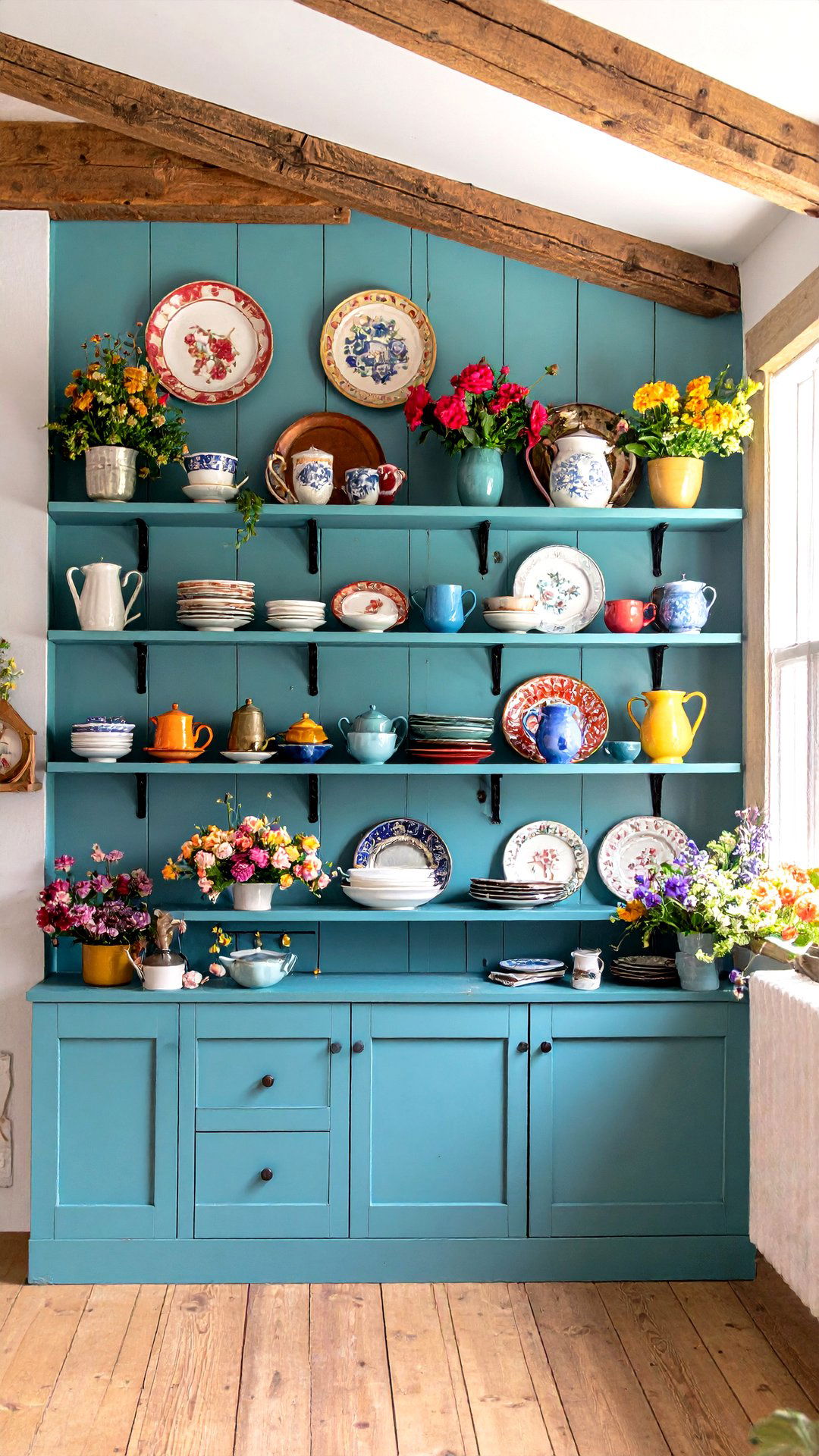
Displaying inherited china or thrifted transferware on open shelves celebrates everyday beauty, says Better Homes & Gardens. Replace a bulky hutch with wall-mounted planks bracketed in wrought iron; the negative space keeps a cottage dining room feeling airy while plates and pitchers become artwork. Paint shelves the same color as the wall so collections pop, or leave bare pine for rustic charm. Rotate vignettes each season — ironstone in winter, blue-and-white in summer — to refresh the room without new purchases. A discreet rail beneath can even suspend mugs, making morning cocoa reach-in convenient.
6. Blue-and-White Coastal Layers Lighten a Cottage Dining Room
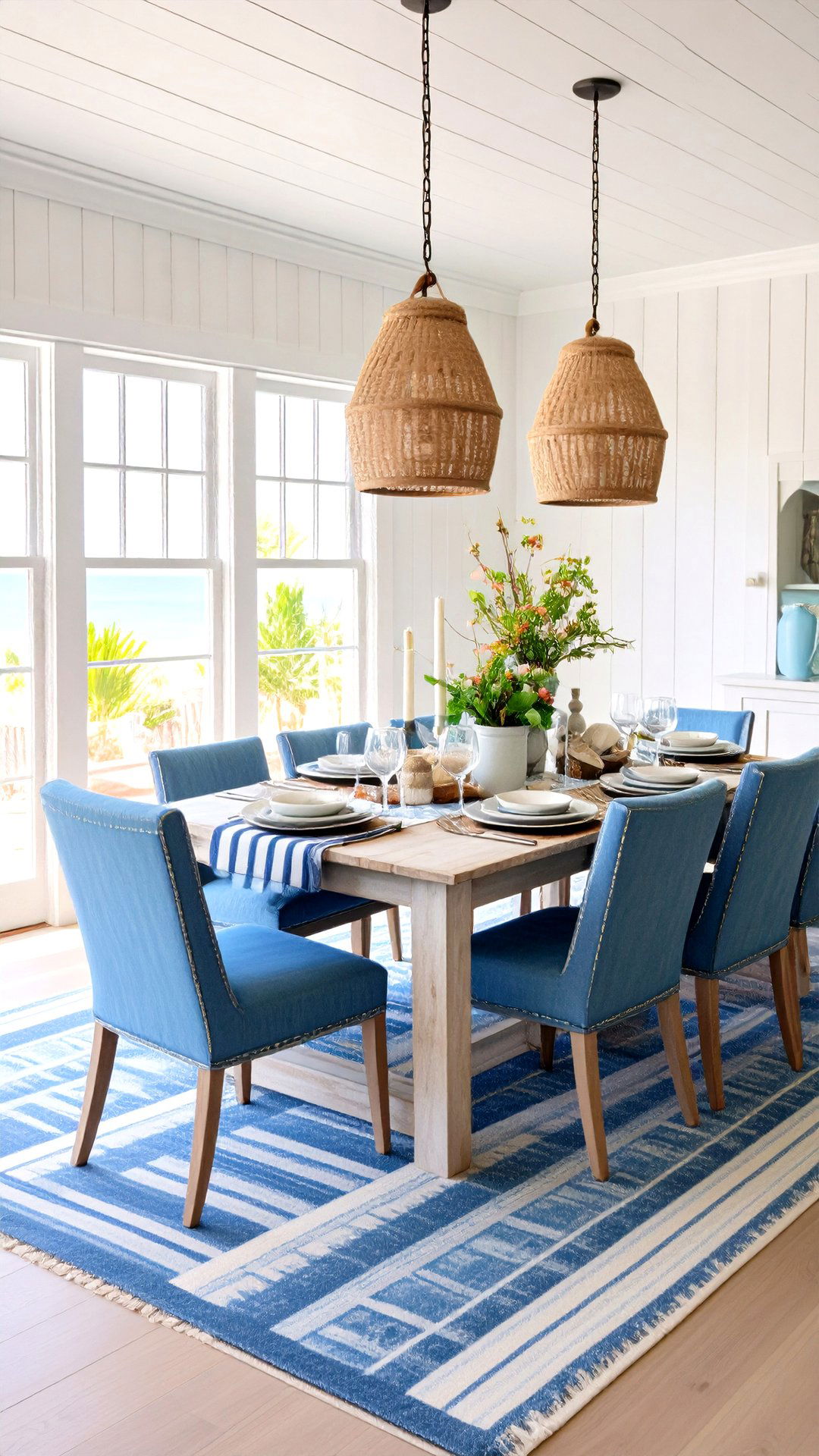
Sea-washed blues paired with crisp white evoke dune walks and salty breezes — even inland. Houzz galleries show that simple swaps like denim slipcovers, striped rugs, and rope-wrapped pendants convert a basic dining zone into a coastal cottage dining room. Keep the palette tight: three shades of blue, plenty of white, plus accents of driftwood and seagrass for warmth. Glossy beadboard wainscoting bounces light, while clear glass hurricanes filled with beachcombed shells double as centerpieces. This approach proves you don’t need ocean views to dine like you do.
7. Farmhouse Bench Seating Adds Flexibility to a Cottage Dining Room
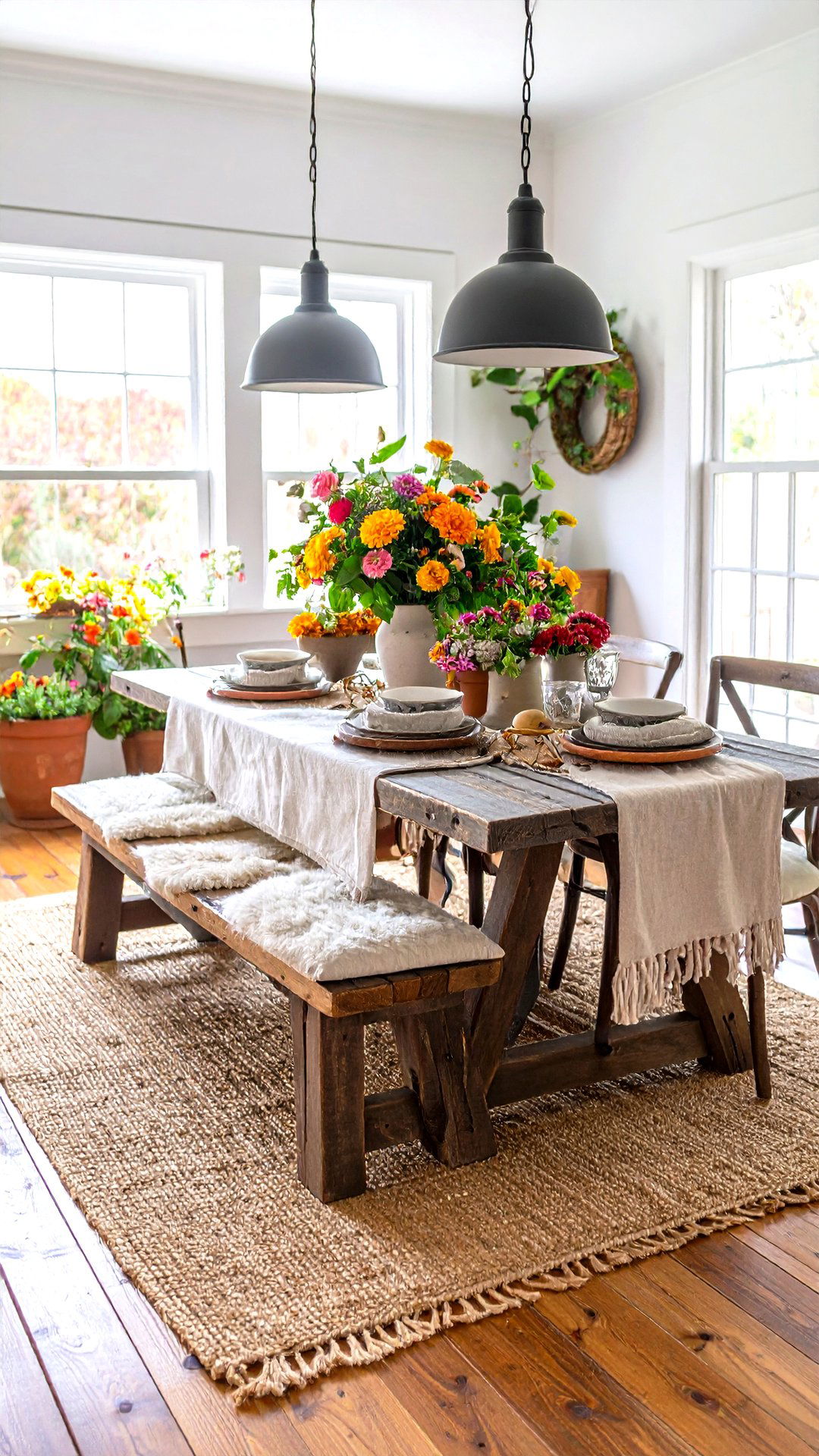
A backless farmhouse bench slides neatly under the table, freeing floor space when the cottage dining room moonlights as homework hub. The Spruce notes benches also cram in cousins during holiday pie tastings without dragging in extra chairs. Look for reclaimed planks with knots intact — imperfections enhance authenticity. To prevent scooting mishaps, add a non-slip jute runner beneath. Top with sheepskins in winter for warmth, then swap to washable cotton pads in summer. The bench’s casual nature sets a laid-back tone where elbows on the table feel perfectly acceptable.
8. Layered Cottage Dining Room Textiles for Instant Warmth
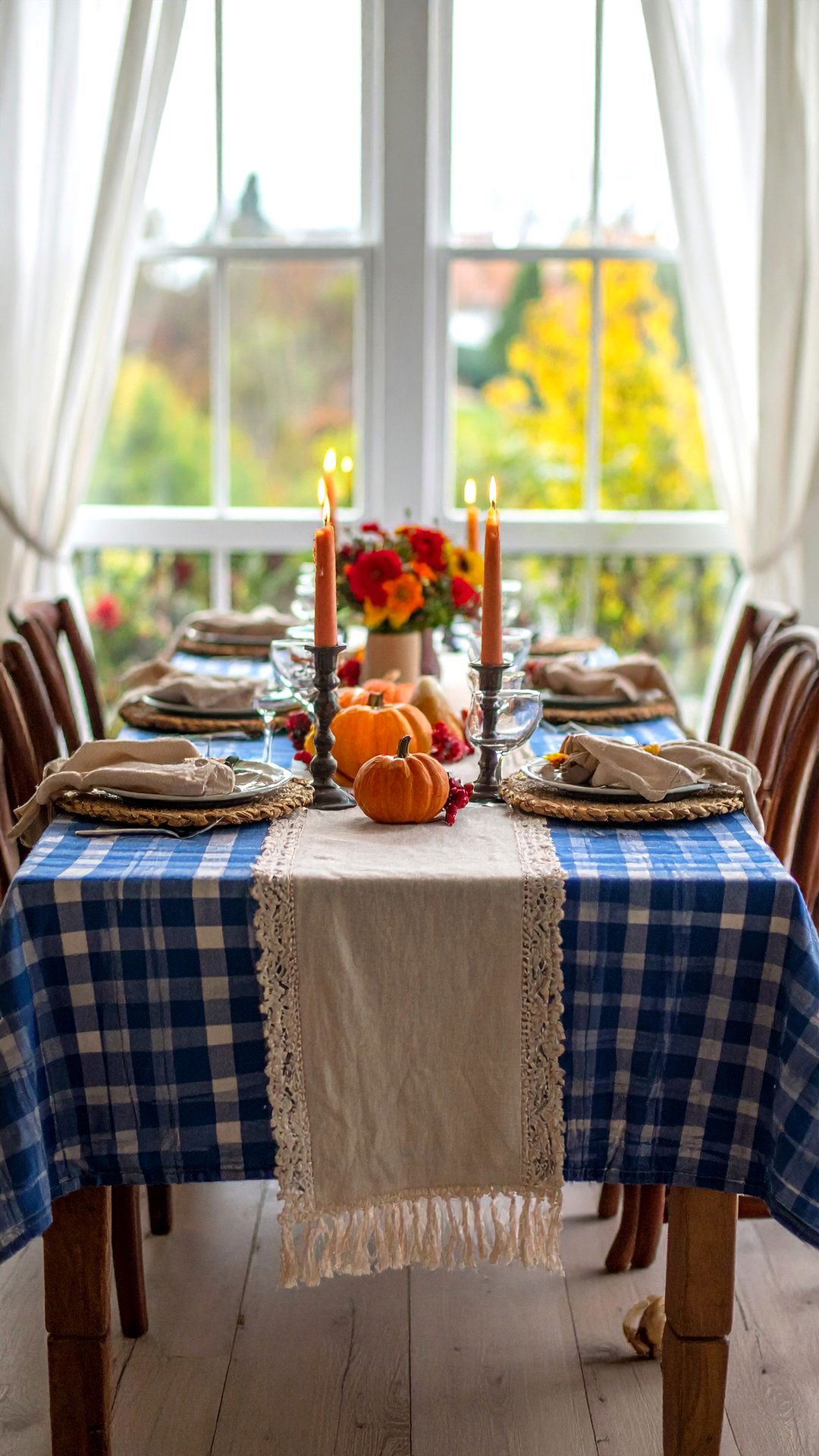
Certainly, nothing softens acoustics like layers of cloth. Country Living’s cottage roundup showcases checkered tablecloths, lace runners, and simple café curtains working together to hush clatter and invite conversation. Combine textures — think burlap chargers under voile napkins — to avoid flatness. Keep colors harmonious so patterns mingle, not clash. If laundering large cloths feels daunting, opt for oversized linen placemats that drape over table edges for a similar cozy effect. Among these layers, candlelight glows richer, and even weeknight pasta feels special.
9. Natural-Fiber Rugs Ground a Cottage Dining Room’s Footprint
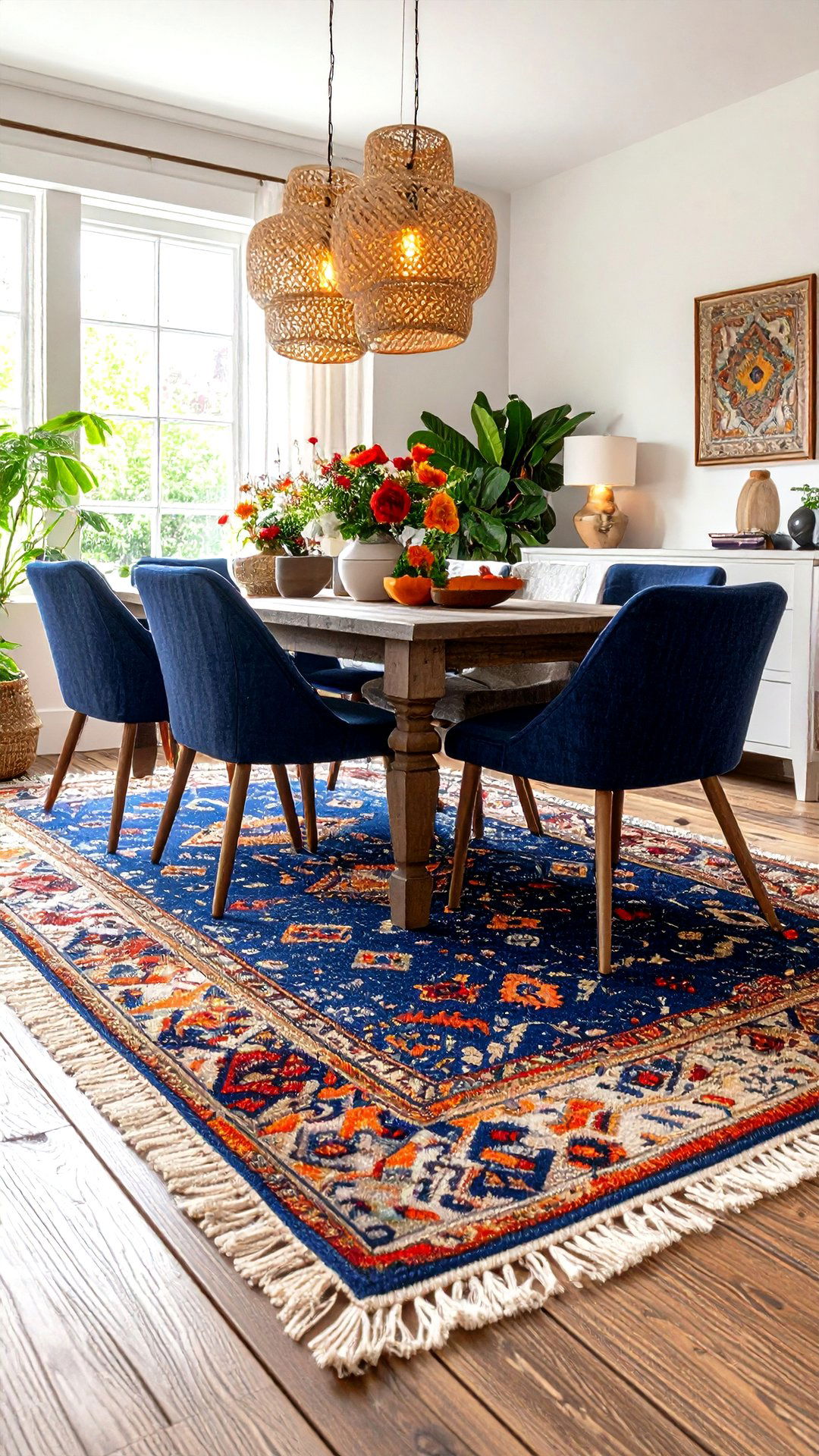
A jute or sisal rug frames the dining zone, defining space in open-plan cottages and protecting vintage floors. The Spruce points out that their chunky weave hides crumbs and stands up to chair drag. Choose a size that extends at least 24 inches beyond chair legs so seating stays stable. Layer a smaller kilim atop for color, echoing hues in seat cushions. Regular vacuuming and occasional sun airing keep fibers fresh. Bonus: earthy rugs tie adjoining living spaces together, creating a cohesive flow throughout the cottage.
10. Rustic Hutch Revival in the Cottage Dining Room

Real Homes’ farmhouse experts love reviving worn hutches with milk-paint finishes, turning storage into a focal point. Remove doors on upper shelves to showcase enamel pitchers and gingham bowls; leave lowers closed for board-game clutter. Swap dated hardware for cup pulls in matte black. Inside, line backs with peel-and-stick plaid for surprise pattern. The refreshed hutch whispers history yet feels updated, reinforcing a cottage dining room’s lived-in narrative while corralling essentials within arm’s reach.
11. Slipcovered Chairs Offer Washable Ease in the Cottage Dining Room
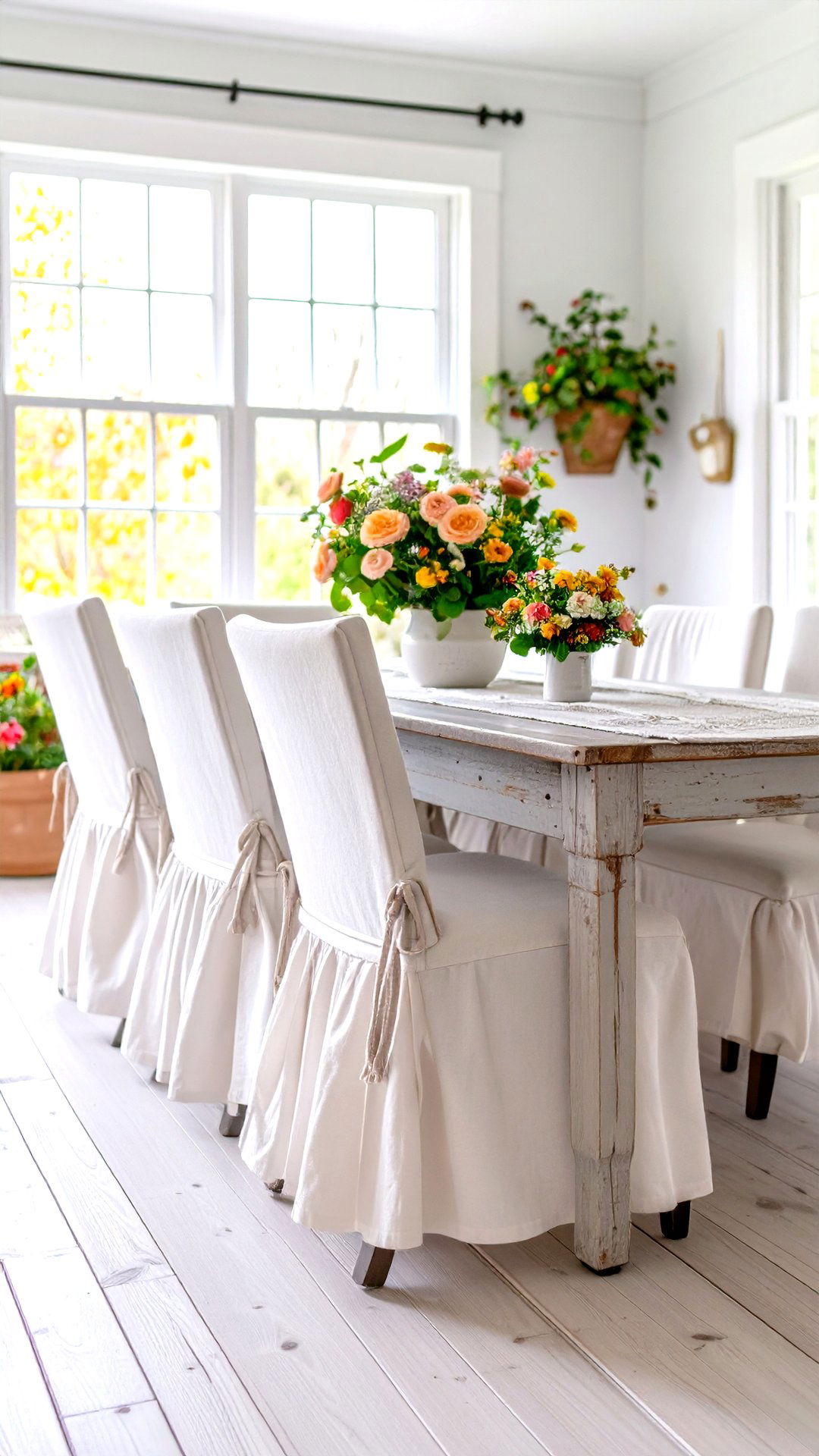
Better Homes & Gardens praises slipcovers as the ultimate cottage practicality: they soften silhouettes and pop off for a quick spin through the washer. Opt for heavyweight cotton duck or linen blends; both drape elegantly and resist pilling. For style, contrast a natural-wood table with crisp white skirts that puddle slightly at the floor. Keep a seasonal second set — maybe ticking stripe for summer, velvety oatmeal for winter — to keep boredom at bay. Snug ties at back corners ensure covers stay in place when kids wiggle through dessert.
12. Statement Lighting Crowns the Cottage Dining Room Ambiance
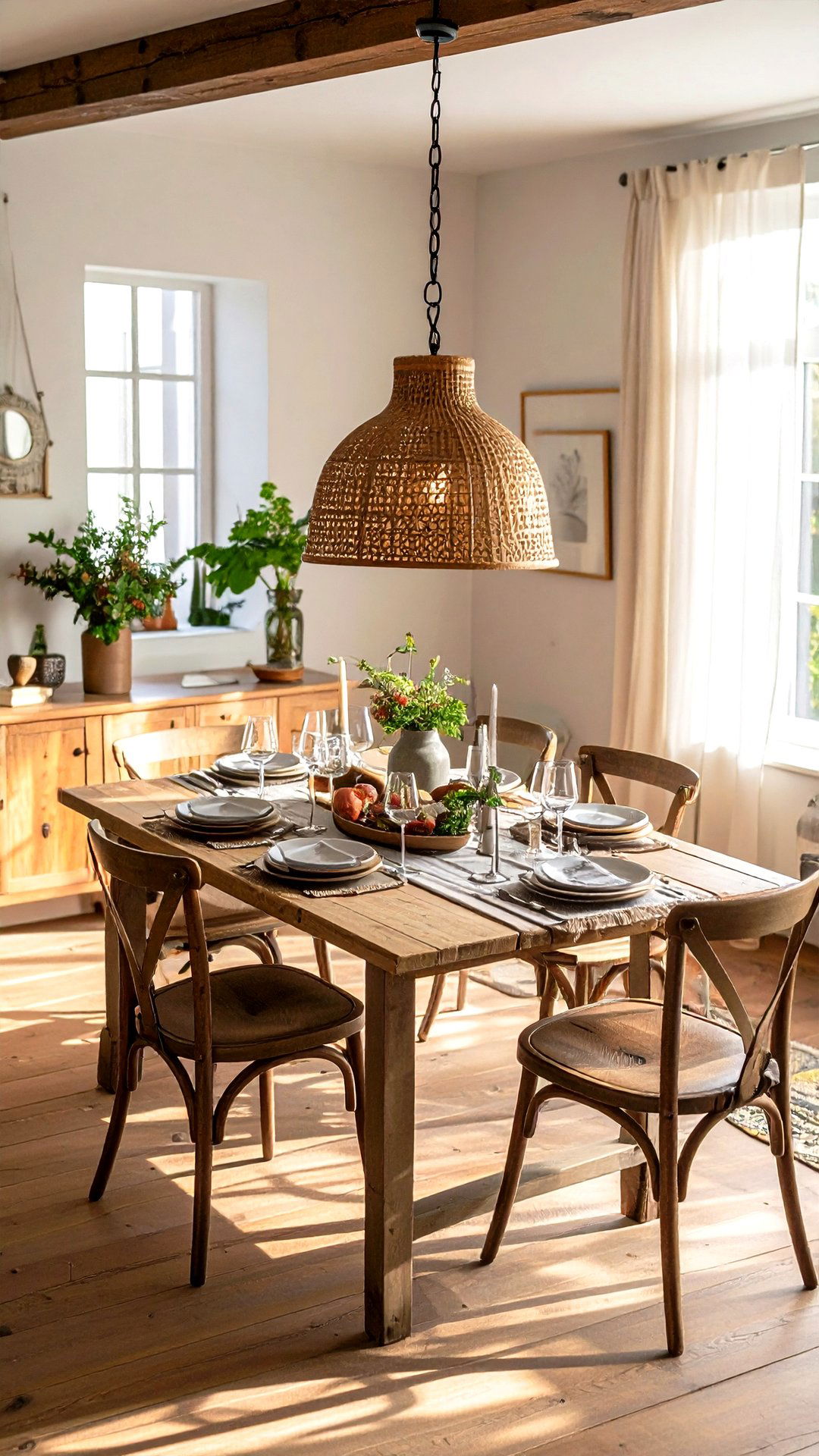
Looking spaces benefit from an eye-catching pendant that feels aged yet fresh. Real Homes’ traditional-style guide recommends lantern cages, beaded chandeliers, or repurposed vintage baskets rewired as shades. Hang fixtures so the bottom sits 30 – 34 inches above the tabletop, ensuring sightlines stay clear. Consider dimmer switches; warm, low light flatters guests and grain alike. Edison bulbs mimic candle glow without open flame risk, while a wicker shade throws patterned shadows that dance over evening suppers.
13. Botanical Gallery Walls Enliven a Cottage Dining Room
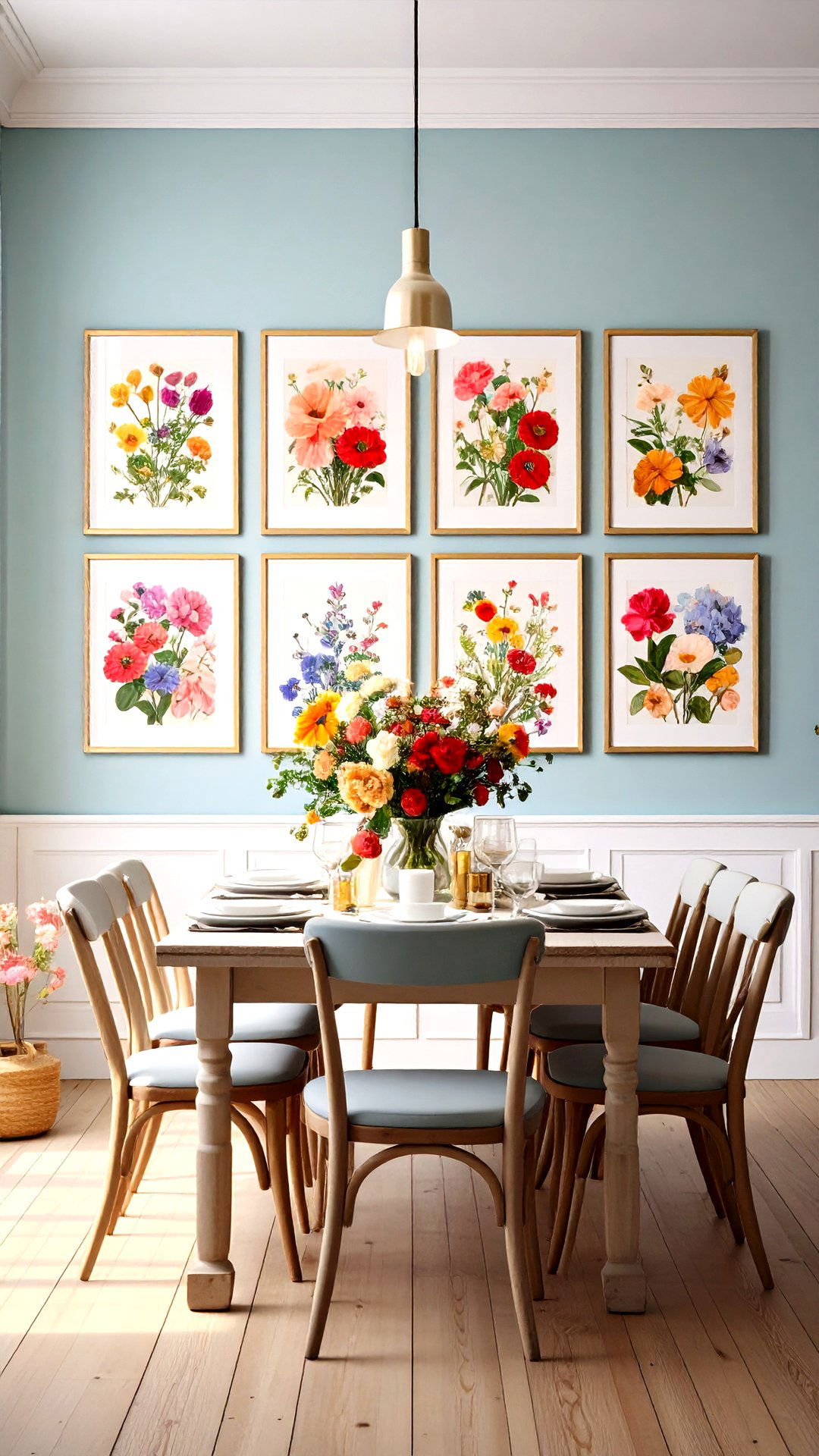
Pressed-flower prints or herb illustrations bring the outdoors in, a principle Better Homes & Gardens extends to small dining corners that lack garden views. Arrange frames salon-style above a wainscot, mixing thrift-shop gold with whitewashed wood for curated charm. Limit your palette — perhaps greens and creams — to keep cohesion. Glass without glare-coating reflects candlelight beautifully, making artwork part of the atmosphere. Rotate pieces seasonally: fern studies in summer, berry sketches in winter. The wall then reads as living scrapbook, evolving with the cottage year.
14. Two-Tone Painted Furniture Refreshes a Cottage Dining Room on a Budget
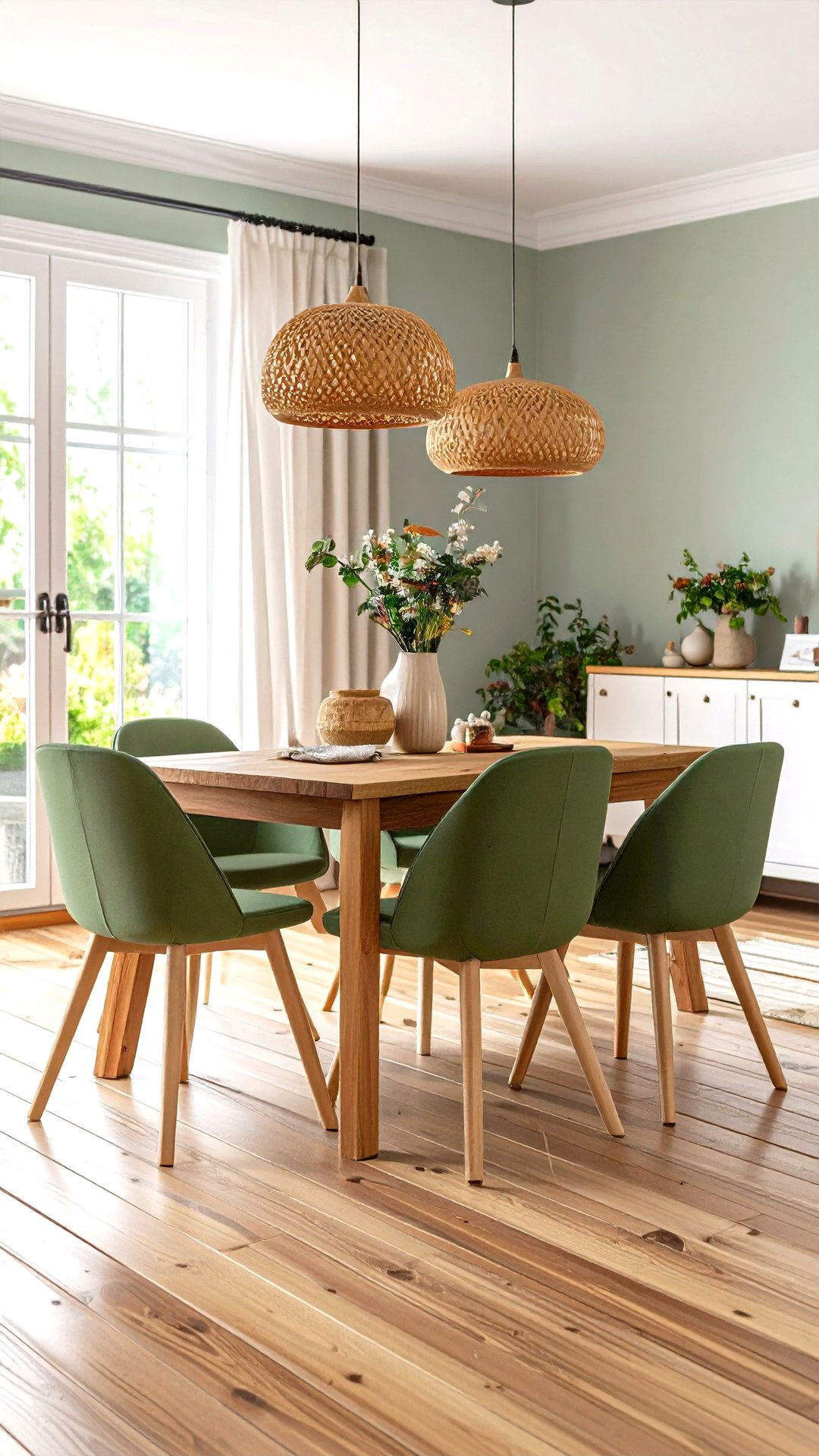
The Spruce’s broad dining-decor roundup suggests splitting chair backs and legs into complementary hues for instant personality. Try creamy bases with olive tops, sealing with matte polyurethane for durability. The technique rescues mismatched thrift finds, uniting them through color while celebrating differing shapes. Extend the idea to sideboards — paint carcasses white, leave drawer fronts natural. The restrained contrast keeps a cottage dining room casual yet considered, proof that paint beats pricey replacements when funds are tight.
15. Seasonal Centerpieces Keep a Cottage Dining Room Feeling Alive
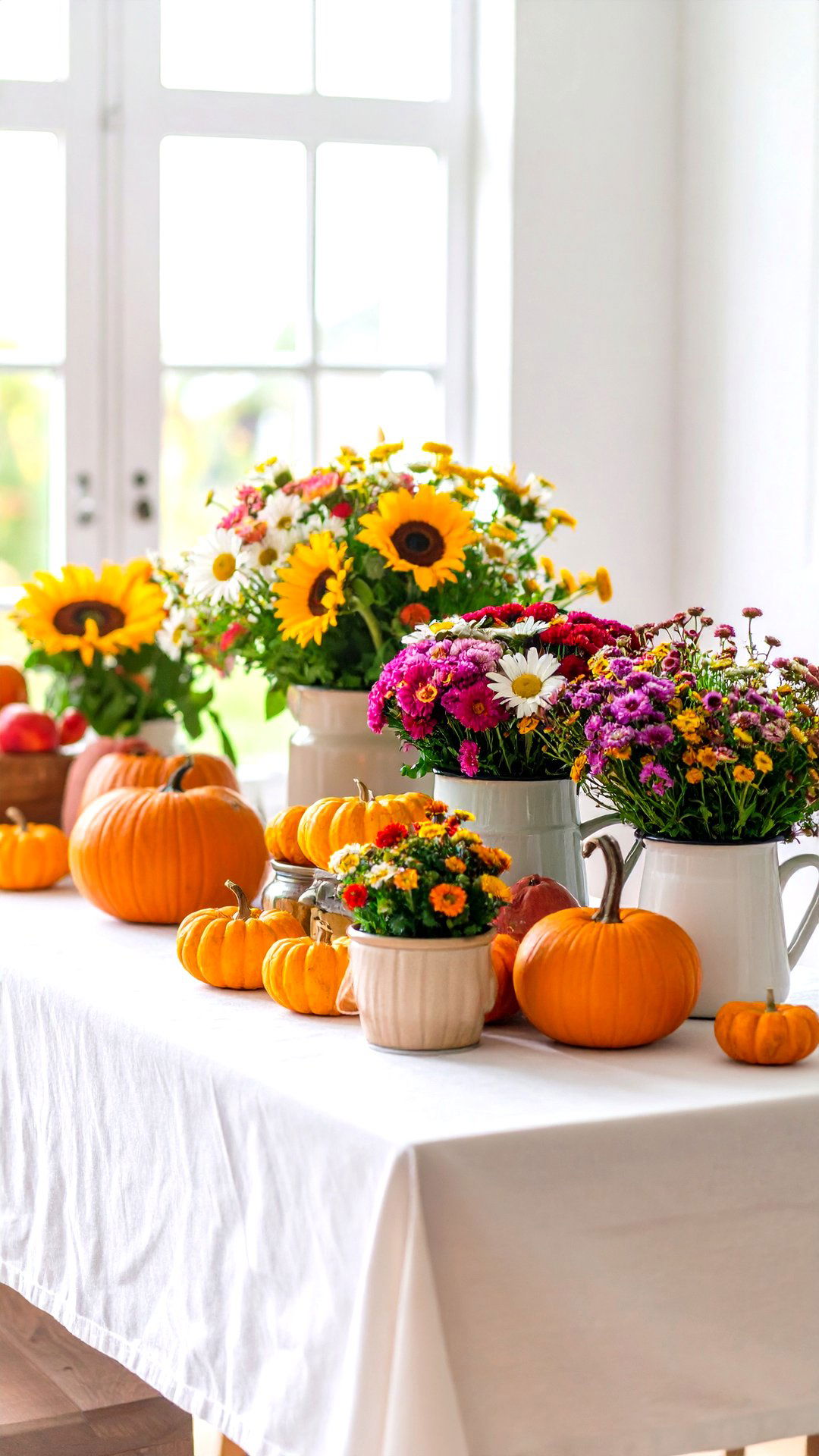
Country Living reminds us that cottage style thrives on spontaneity — just-picked daisies in May, mini pumpkins come October. Use simple vessels: enamel coffee pots, vintage jam jars, or even a loaf tin lined with wax paper for meadow grasses. Vary heights to maintain conversation sightlines. Between floral moments, a wooden dough bowl piled with apples or pinecones maintains interest. These low-cost switches let the cottage dining room mirror surrounding landscapes, deepening the sense of place without constant redecorating.
16. Curtain-Free Windows for Sun-Drenched Cottage Dining Rooms
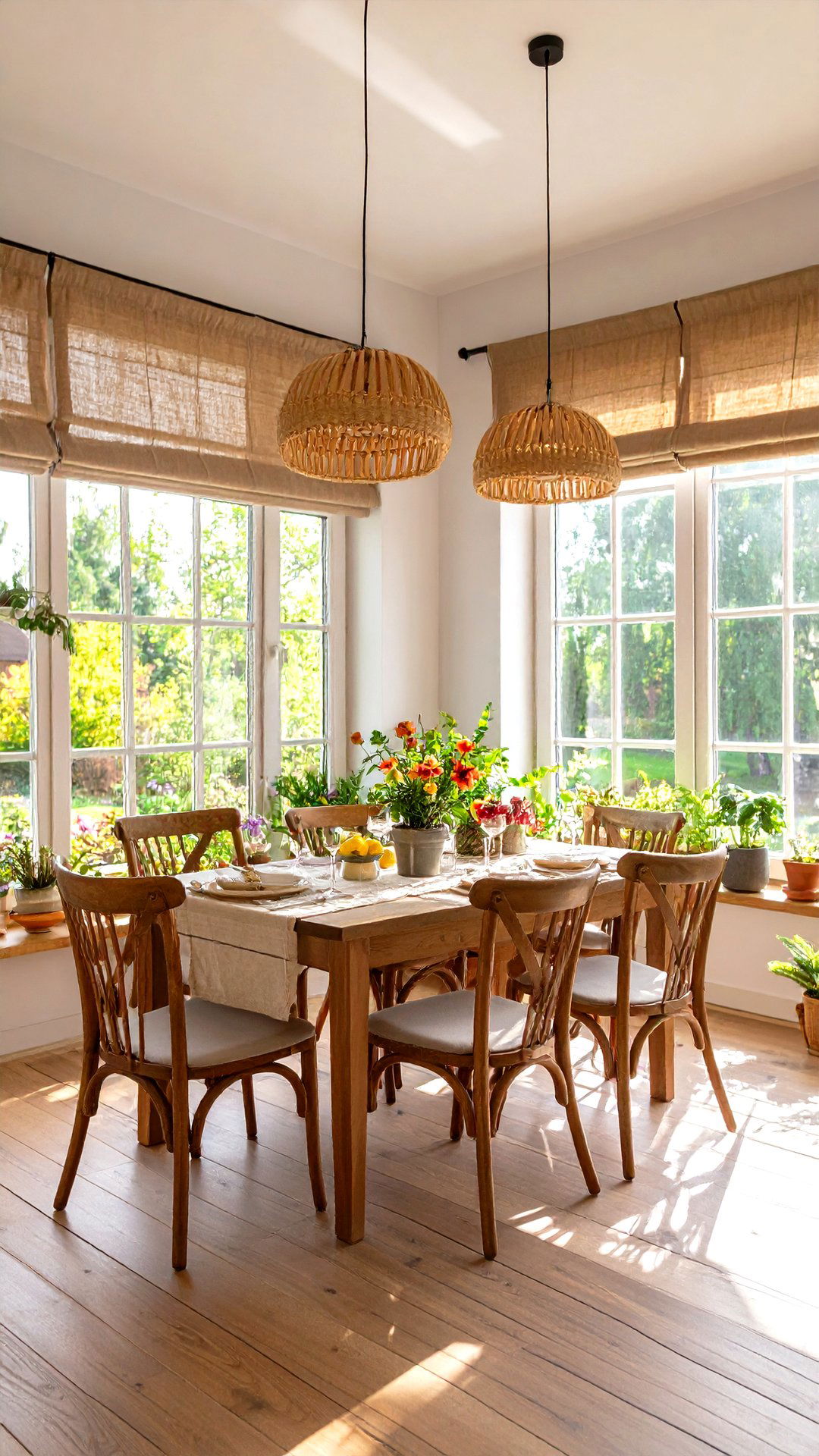
Rooms blessed with private views can skip heavy drapes, embracing the light-filled aesthetic championed by cottage designers at Better Homes & Gardens. Bare mullions visually enlarge tight quarters and spotlight garden greenery as living artwork. If privacy is occasionally needed, install simple café curtains halfway up or add roll-down bamboo shades that disappear when raised. The flood of daylight boosts mood, makes meals feel alfresco, and supports houseplants stationed on the sill — all without costing a cent.
17. Baskets as Wall Art Add Texture to a Cottage Dining Room
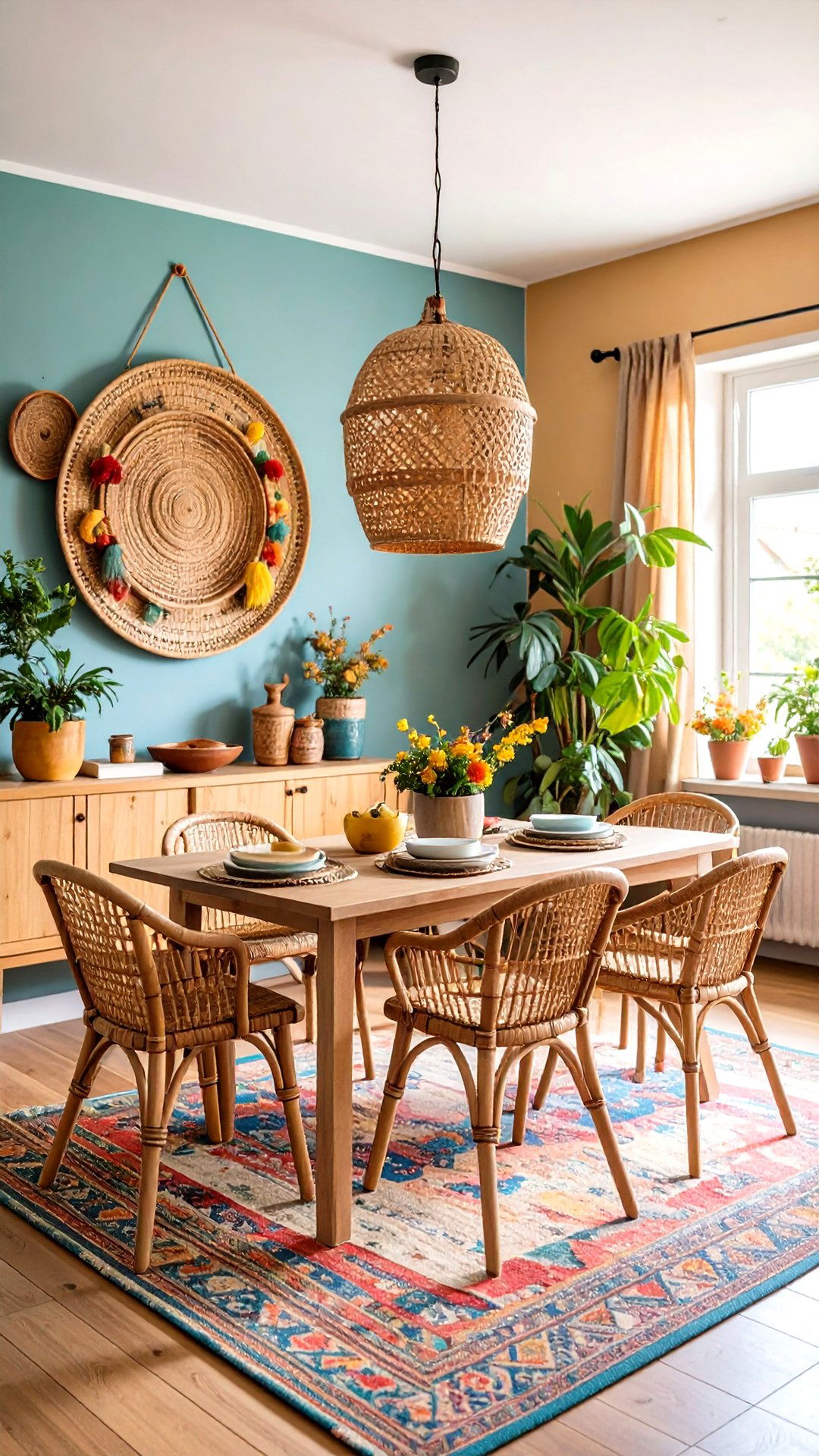
Real Homes’ cottage-style homes guide highlights shallow woven trays arranged organically across a wall for three-dimensional interest. Mix tones — from blonde seagrass to dark willow — for depth, and anchor the layout with one oversized piece. Because baskets are lightweight, small nails suffice, making this renter-friendly. Beyond aesthetics, a couple remain functional: unhook to pass bread during family feasts. Texture-rich art like this reinforces the handmade spirit underpinning every welcoming cottage dining room.
18. Painted Beadboard Wainscoting Warms a Cottage Dining Room Shell
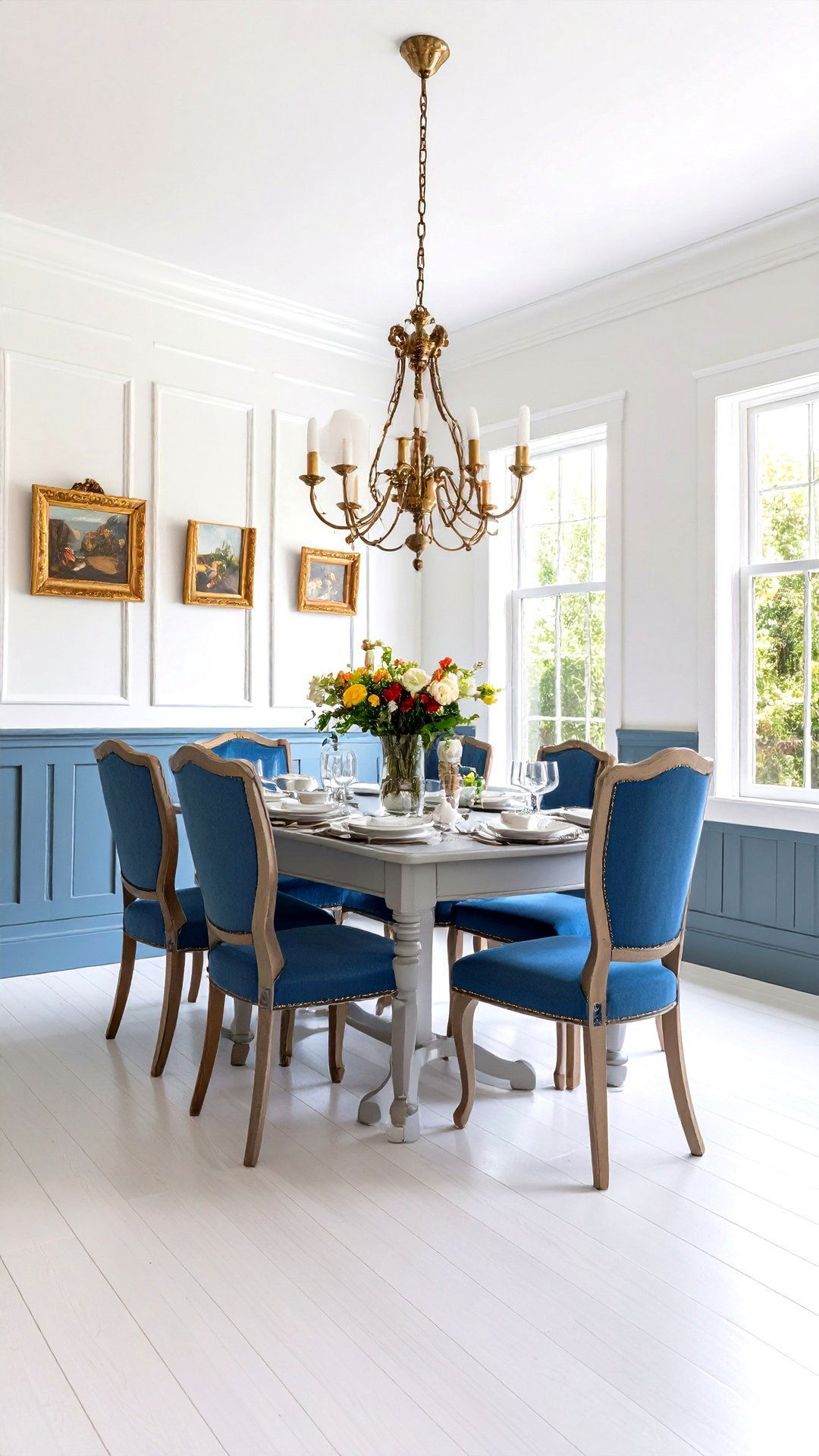
House & Home spotlights beadboard as a timeless cottage envelope that hides wall woes while adding rhythmic shadow lines. Paint lower panels a muted moss or dove gray, leaving walls above crisp white so artwork stands out. The durable surface resists chair scuffs, making it family-friendly. Cap with a narrow plate rail to display dessert plates or tiny oil paintings. Installation is DIY-approachable with pre-primed boards and brad nails, turning blank walls into architectural love letters to country living.
19. Barn Door Accents Give a Cottage Dining Room Rustic Drama
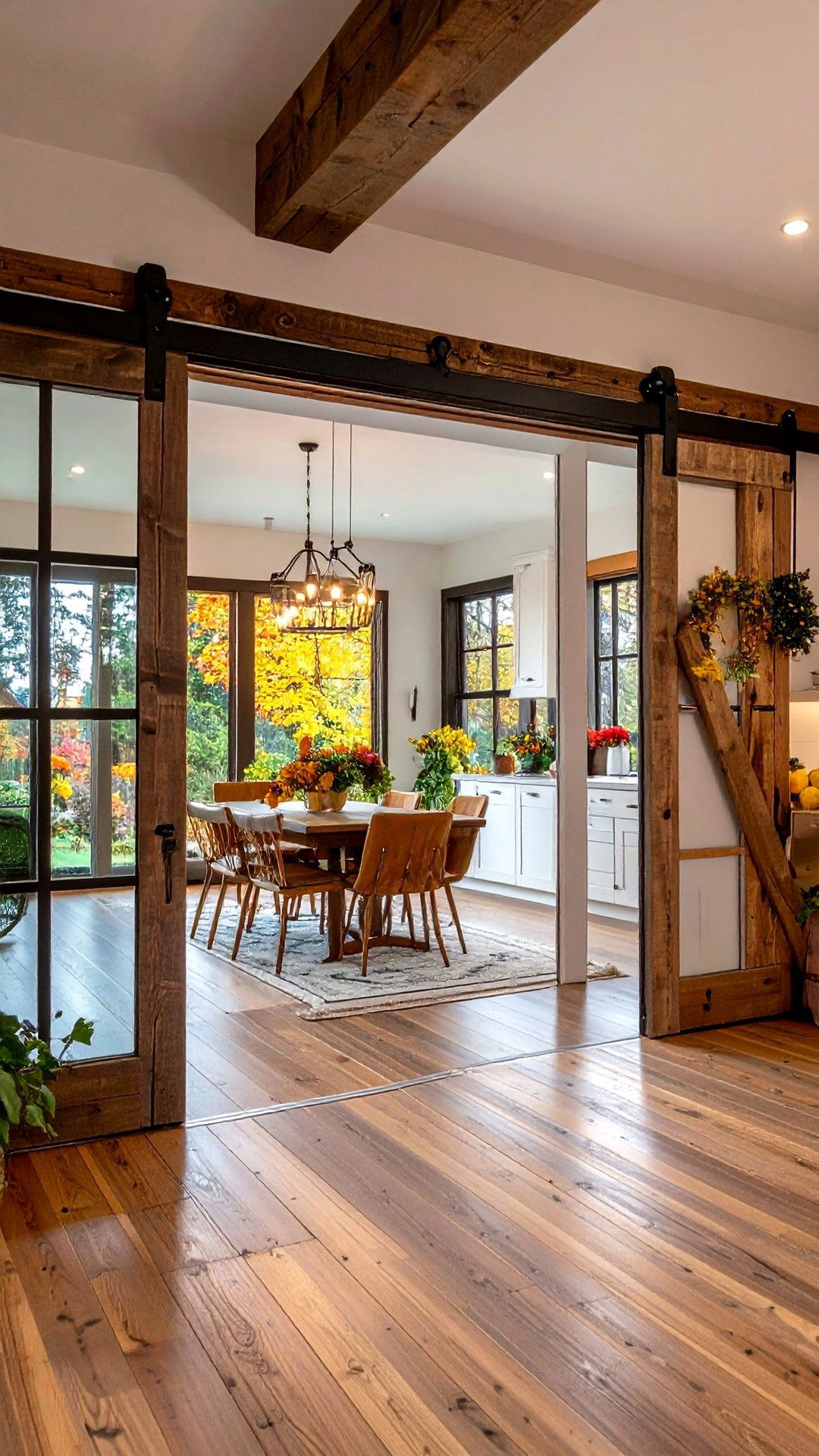
Houzz’s farmhouse galleries prove a sliding barn door can separate kitchen mess from dining calm without stealing floor swing. Choose weathered planks to contrast fresh walls, and fit matte-black hardware for modern edge. Doors double as art when closed; when open, they reveal meals with theatrical flair. Mounting overhead keeps baby fingers safe from pinches. For small cottages, mirrored barn doors bounce light and visually widen hallways.
20. Heirloom Wood Accents Tell Stories in the Cottage Dining Room
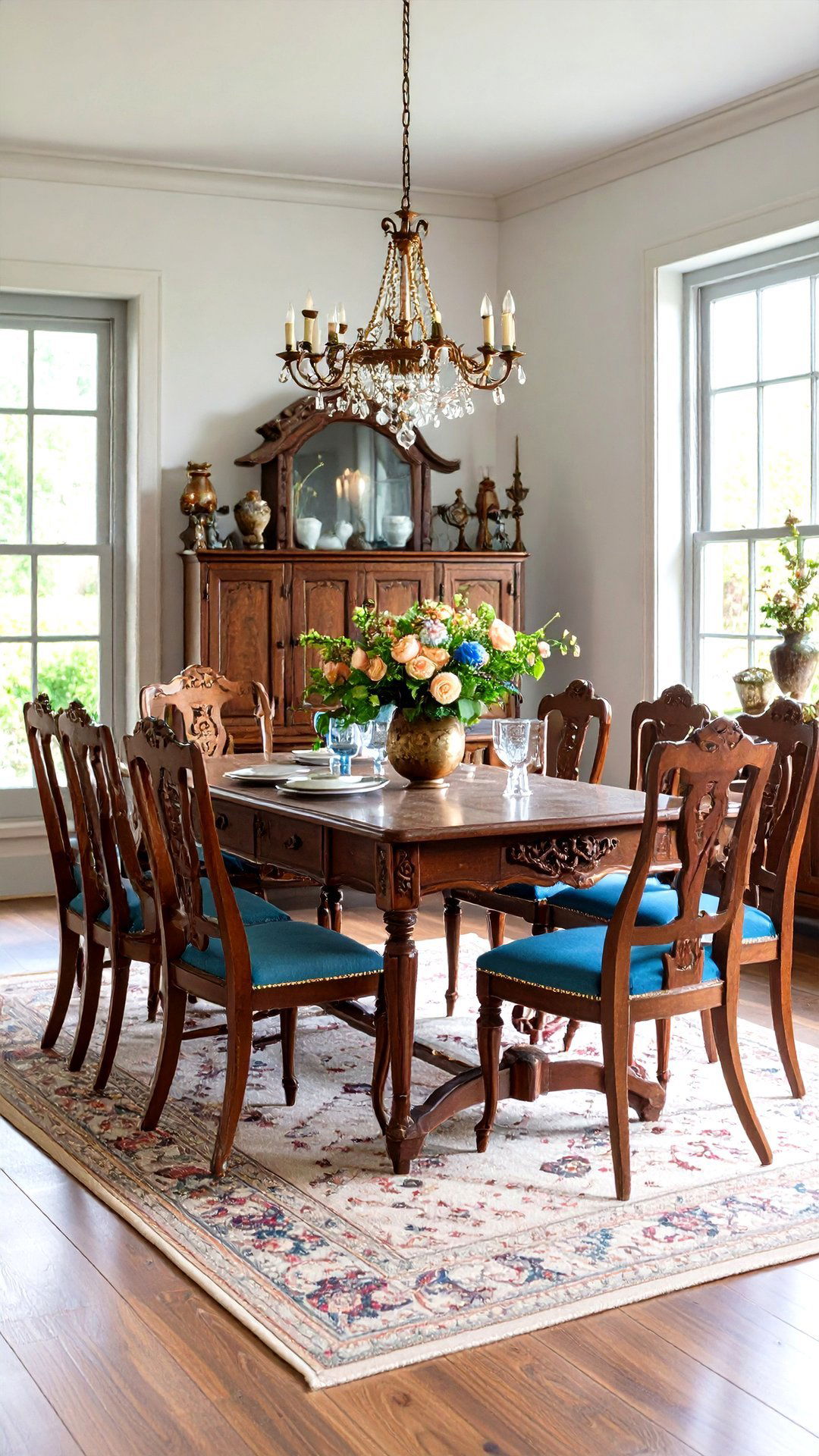
Architectural Digest’s tour of an “imperfect” English cottage praises furniture bearing family patina over showroom sheen. A grandfather’s carved sideboard or thrifted dough trough signals continuity, grounding new paint choices with authenticity. Integrate heirlooms confidently: flank the ornate piece with simple Shaker chairs so it shines. Period imperfections become conversation prompts, weaving history into every shared meal and reminding guests that hospitality matters more than pristine perfection.
21. Rattan and Wicker Details Bring Breezy Texture to the Cottage Dining Room
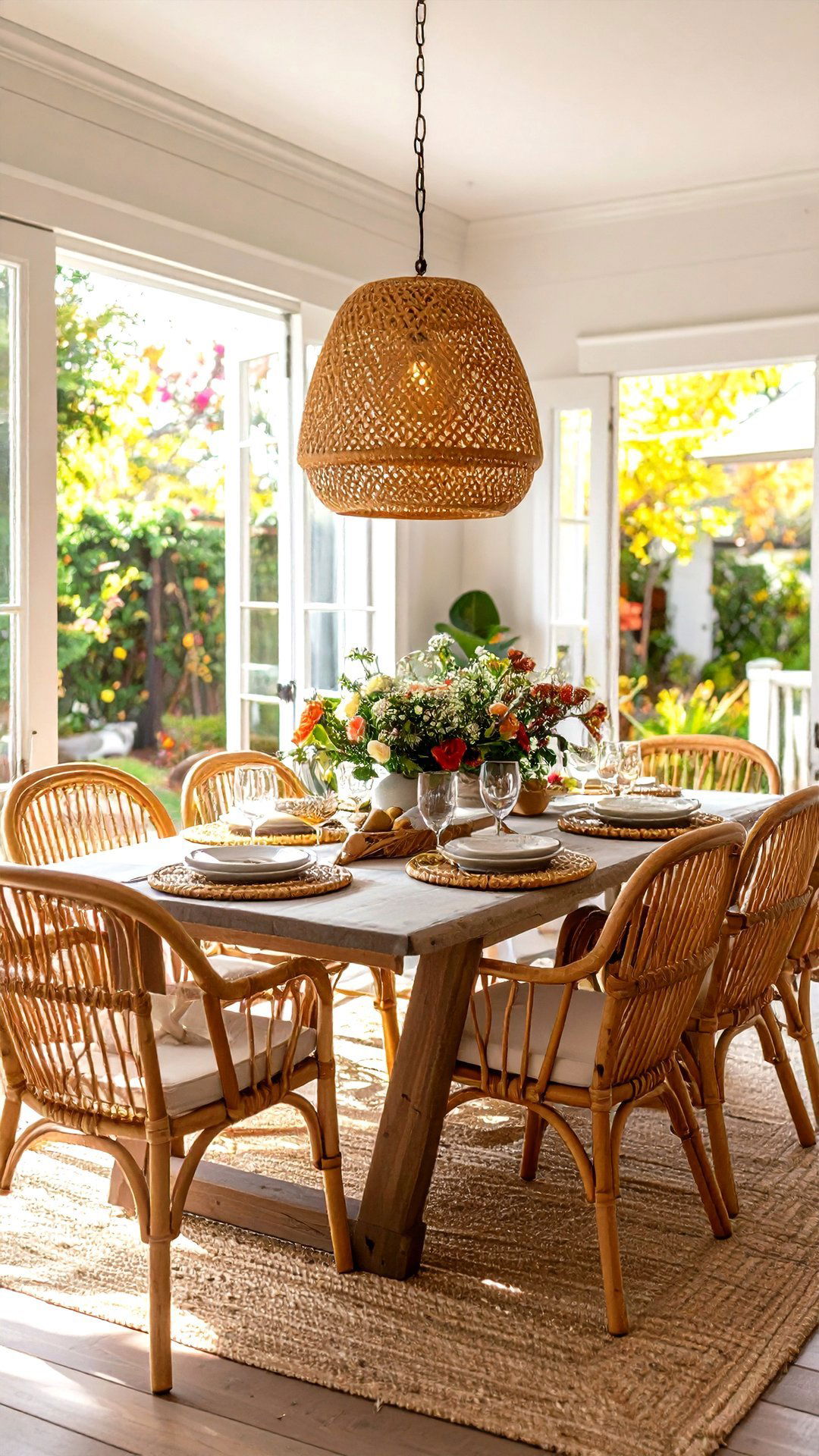
Coastal-minded designers at The Spruce champion rattan light shades, wicker chargers, and cane-back chairs for adding casual ease without reading beach-theme kitsch. Keep finishes sun-bleached or honey-gold; avoid dark stains that feel colonial rather than cottage. Because natural fibers handle humidity changes well, they’re perfect near porch doors that swing open on warm nights. A quick dusting revives their luster, making them low-maintenance style heroes.
22. Wildflower-Inspired Color Pops Energize a Cottage Dining Room Neutral Base
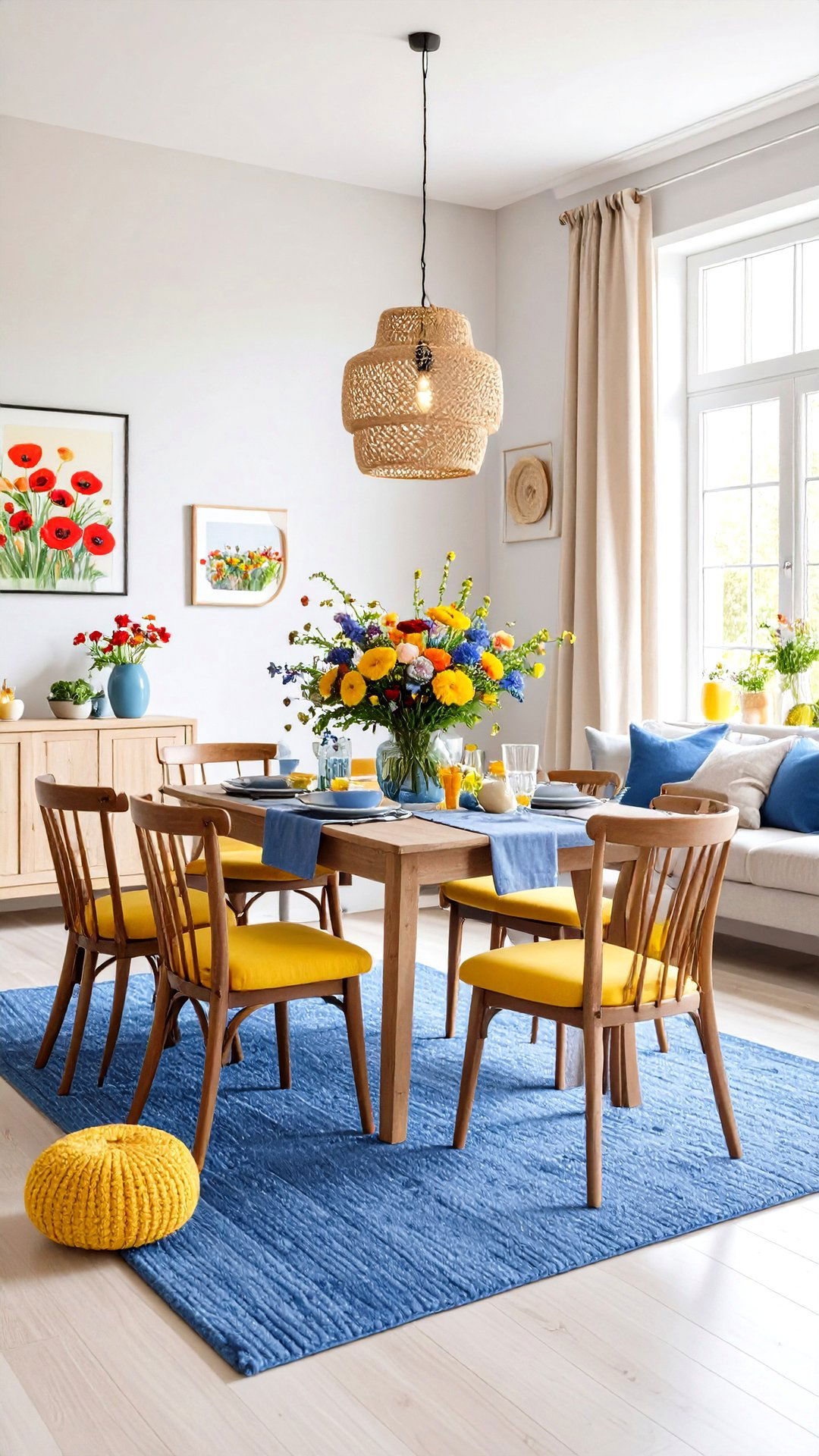
Country Living’s decor editors recommend treating cream walls as a blank meadow, then sprinkling in buttercup yellows, cornflower blues, and poppy reds through cushions and art. Seasonal pillow swaps cost little yet refresh the room’s mood. Keep brighter hues below eye level — seat pads, rugs — while accessories above remain calm, preventing visual overwhelm. In winter, dial back to muted tones, letting candlelight supply warmth. This adaptive palette mirrors the countryside evolving outside cottage windows.
23. Compact Round Tables Make Small Cottage Dining Rooms Social
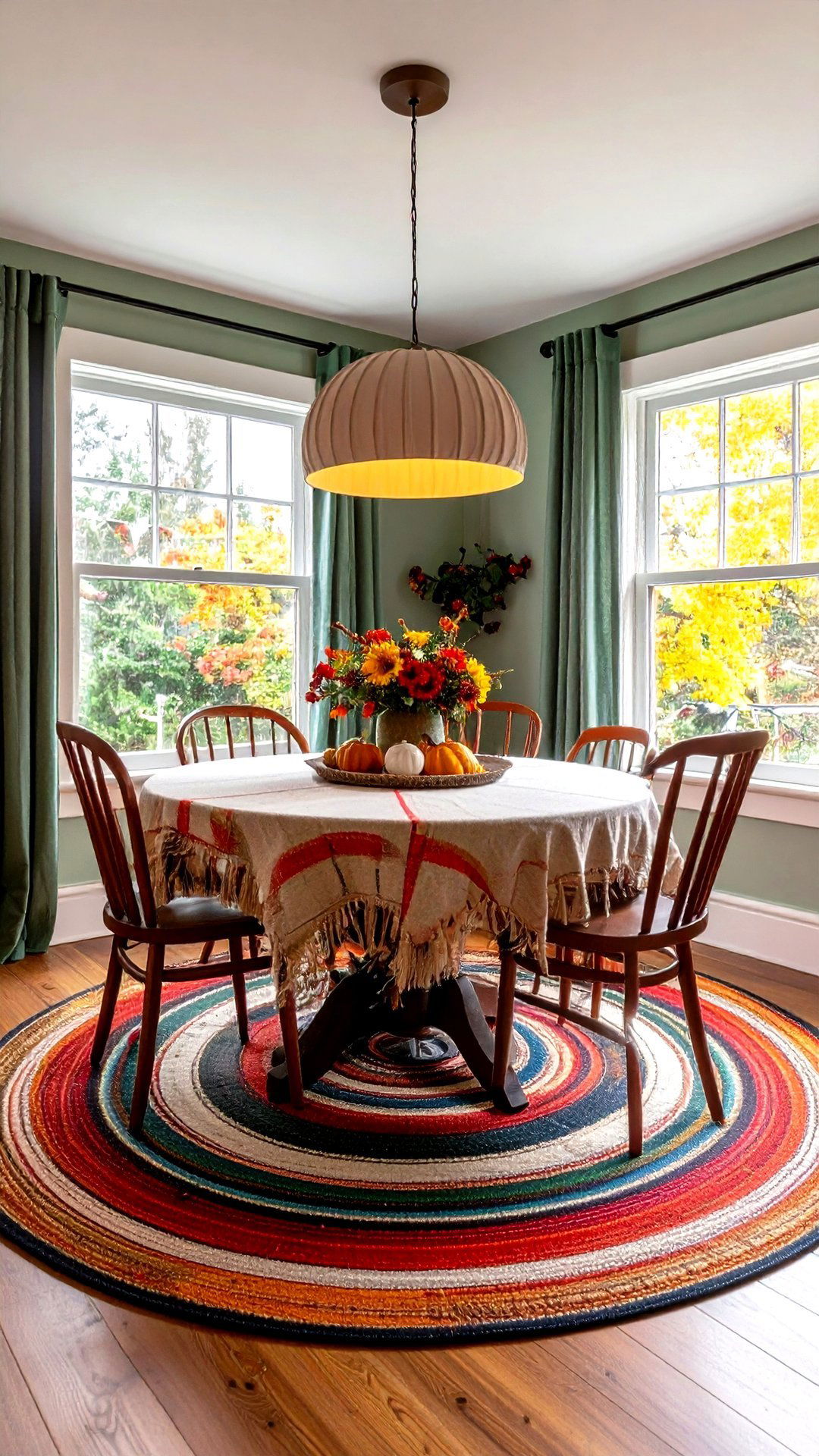
Real Homes notes that a 42-inch pedestal round squeezes into bay windows yet seats four comfortably, fostering face-to-face conversation. Choose one with a leaf for holiday expansion. Chairs tuck fully beneath, preserving circulation paths. A striped round rug echoes the shape to delineate the zone. Above, a circular pendant reinforces friendly symmetry, proving limited footage needn’t limit hospitality.
24. French Doors Blur Lines Between Cottage Dining Room and Garden

The Spruce emphasizes that adding or repainting existing French doors invites daylight and encourages alfresco mingling when weather cooperates. Paint mullions soft sage to blend with garden foliage, visually extending greenery indoors. Install lightweight voile panels on tension rods for gentle privacy without blocking views. When flung open, the doorway frames herb-filled planters, making seconds on rosemary-roasted potatoes simply a step away.
25. Story-Rich Tabletop Collections Personalize a Cottage Dining Room
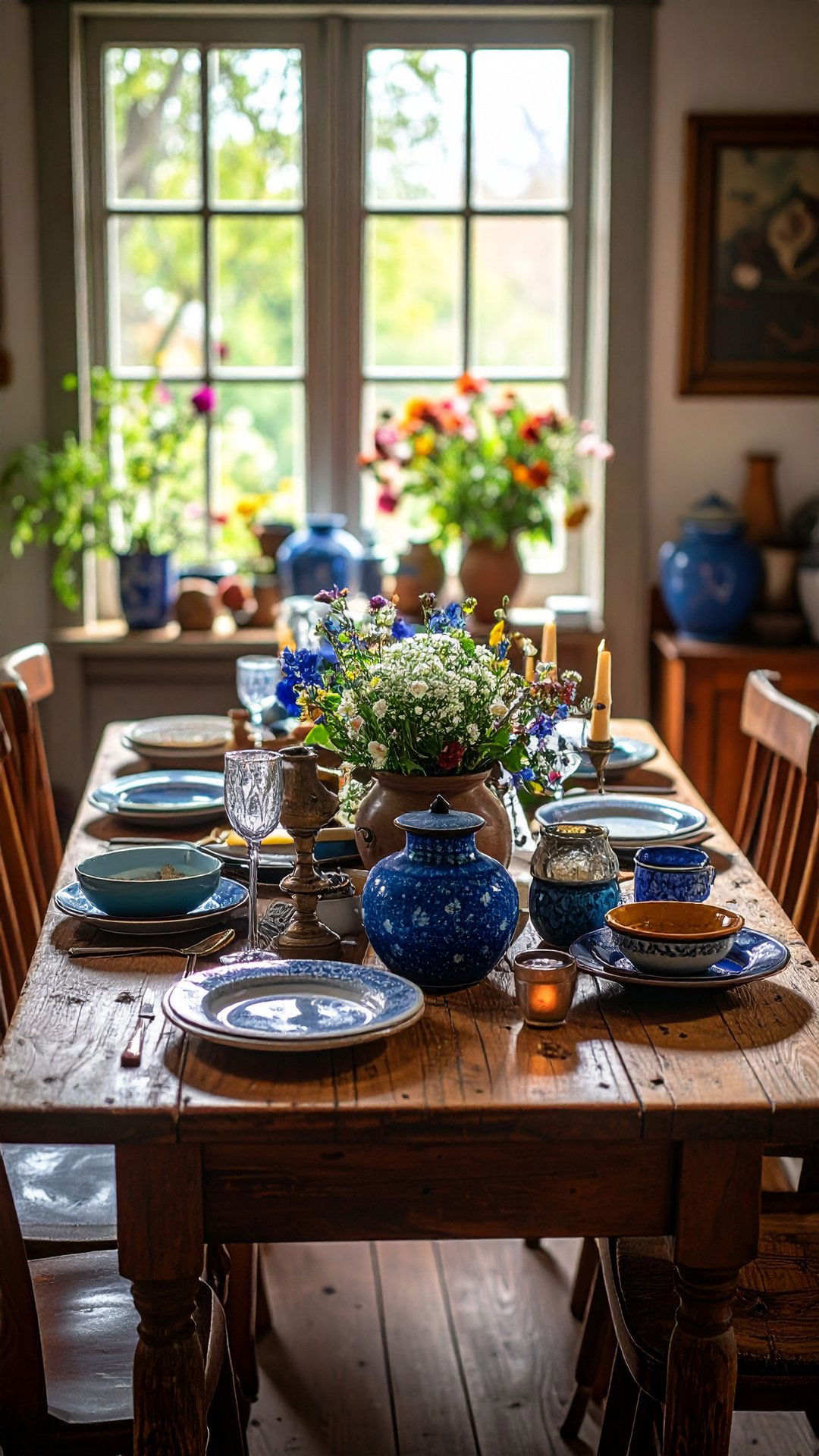
Real Homes’ farmhouse feature insists collected centerpieces — vintage salt cellars, mismatched candlesticks, hand-thrown pottery — turn anonymous rooms into narratives of travels and family finds. Rotate groupings monthly to keep dust manageable and eyes intrigued. Elevate a few items on stacked books or small cutting boards for height variation. The ever-changing vignette sparks dinner conversation and reminds guests that a cottage dining room is foremost a reflection of the people who gather there.
Conclusion:
From weathered timber foundations to fresh wildflower pops, each strategy above proves that a cottage dining room thrives on authenticity, tactile comfort, and a dash of whimsy. Layered textiles cushion sound, open storage spotlights heirlooms, and adaptable lighting nurtures atmospheres from sunrise scones to candlelit stews. Whether you lean coastal, farmhouse, or classic English, the guiding thread is heartfelt informality — spaces designed less for perfection than for togetherness. Bring in the pieces that tell your story, let natural light and nature’s colors guide the palette, and your dining room will welcome every guest like an old friend.


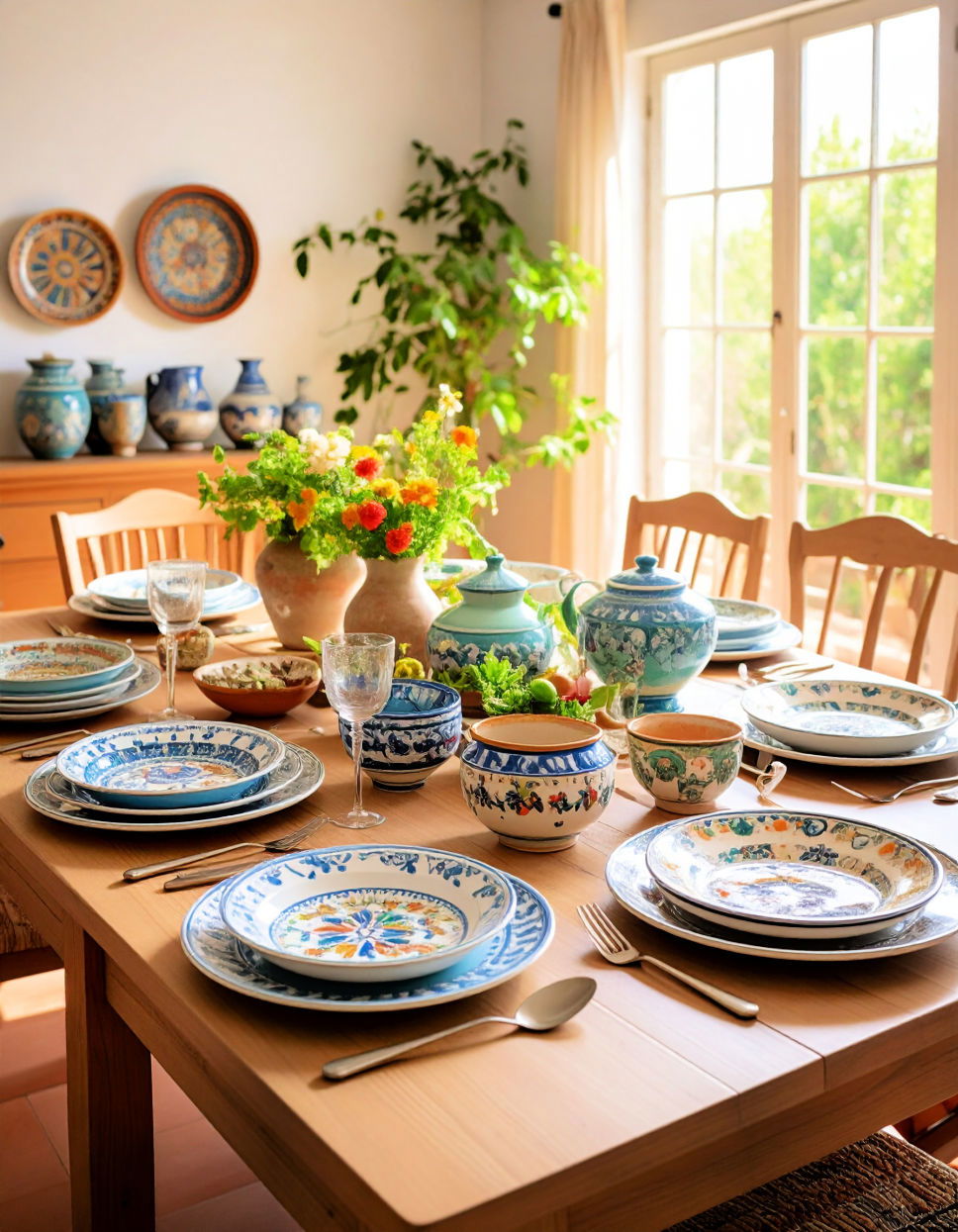

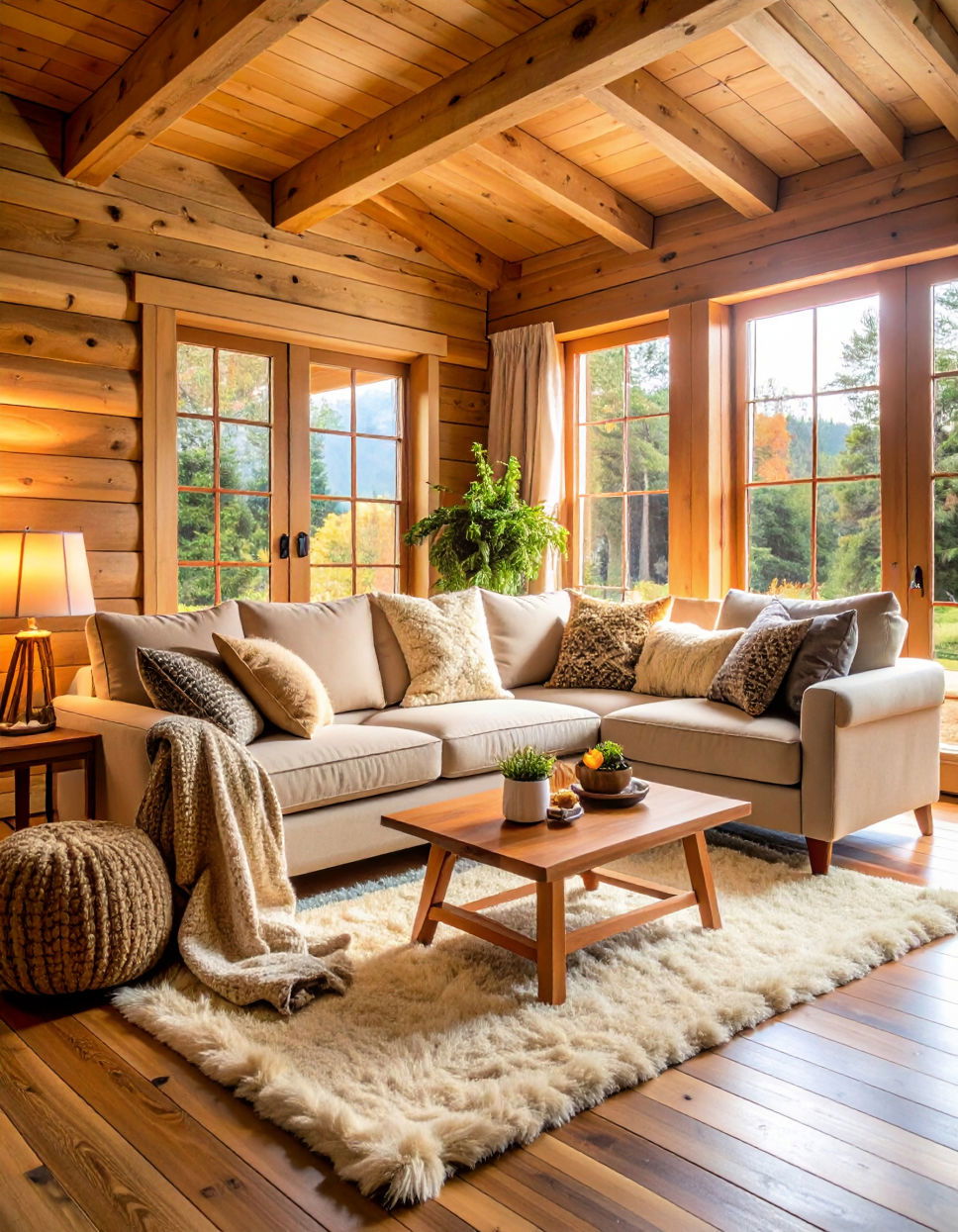

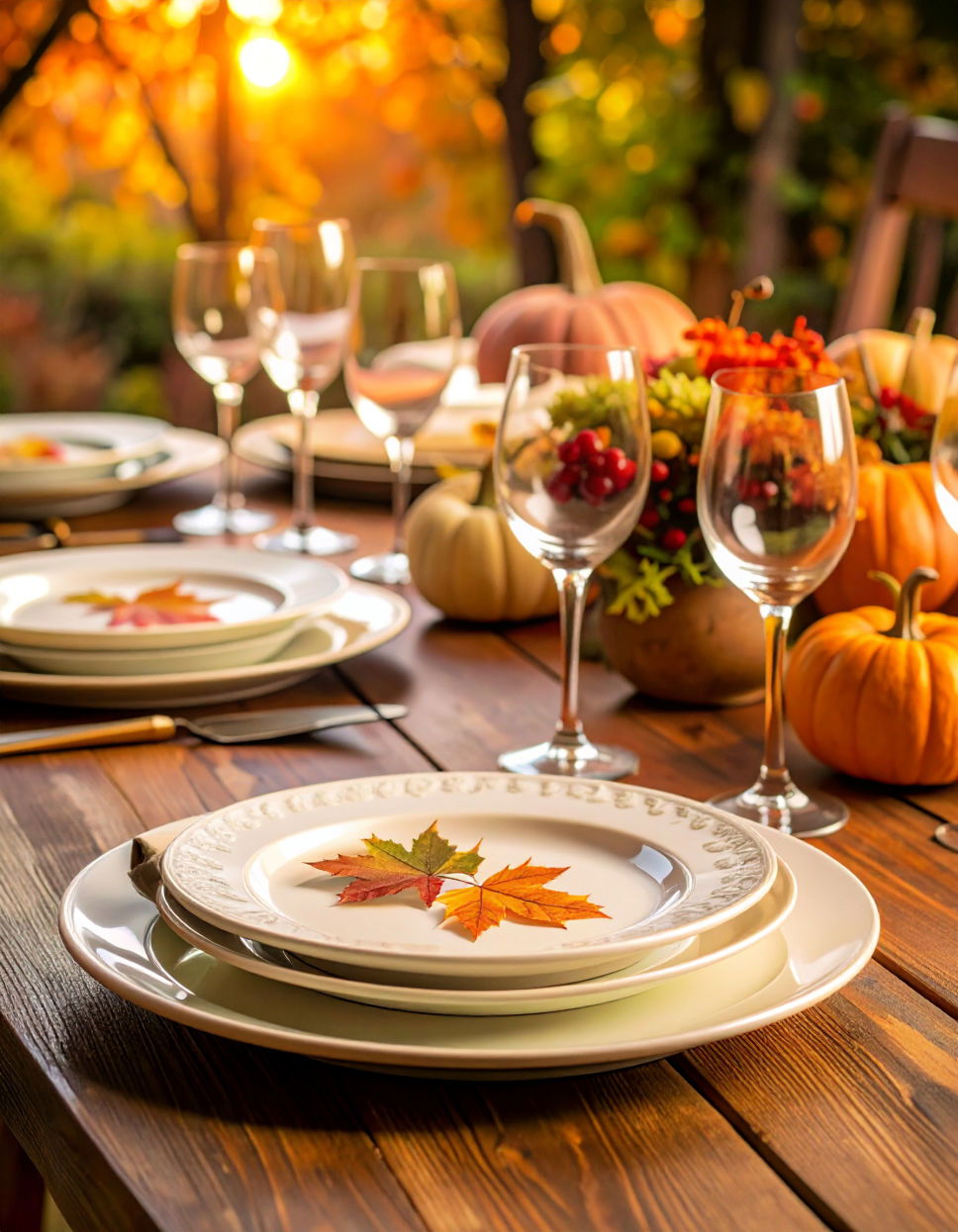
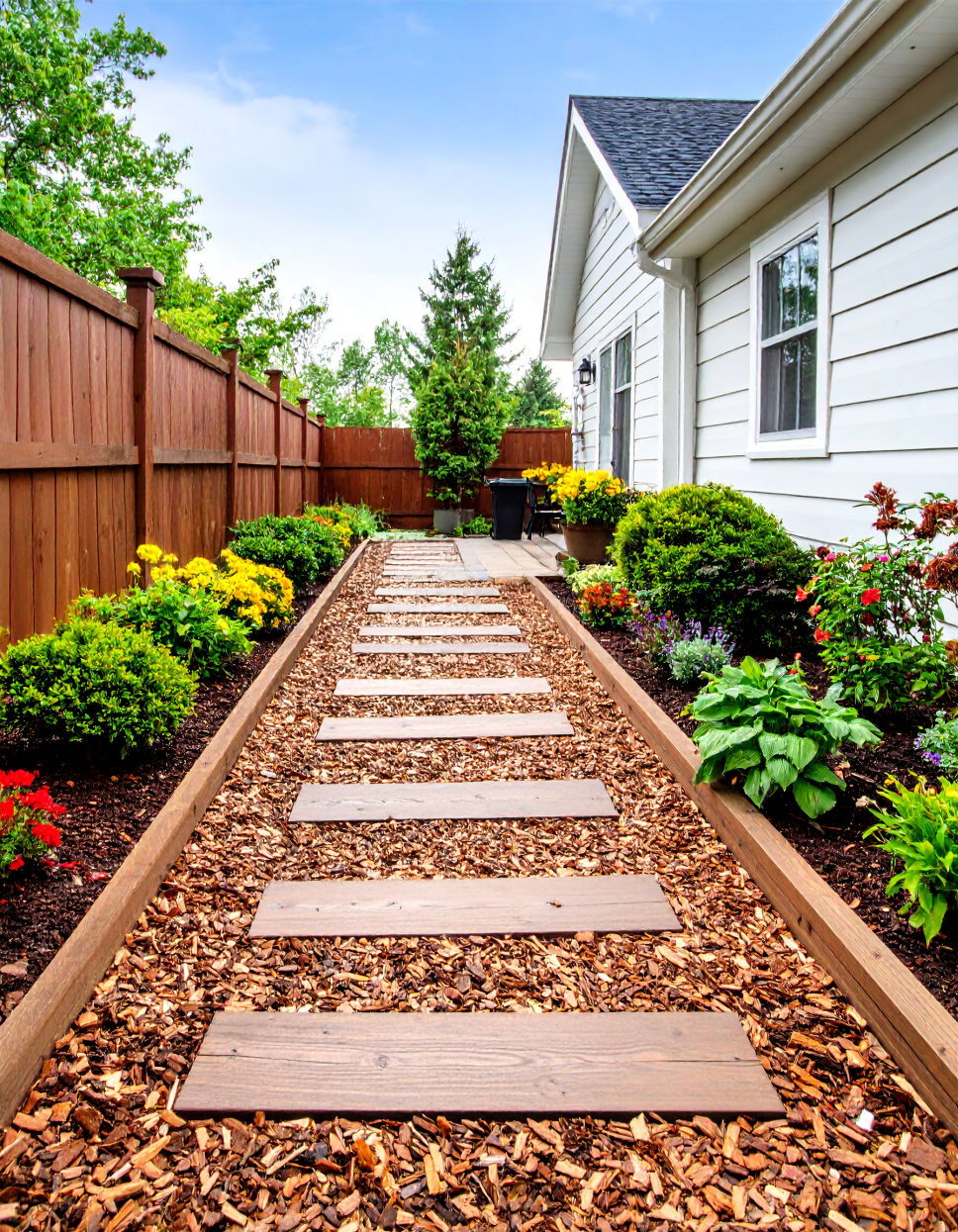


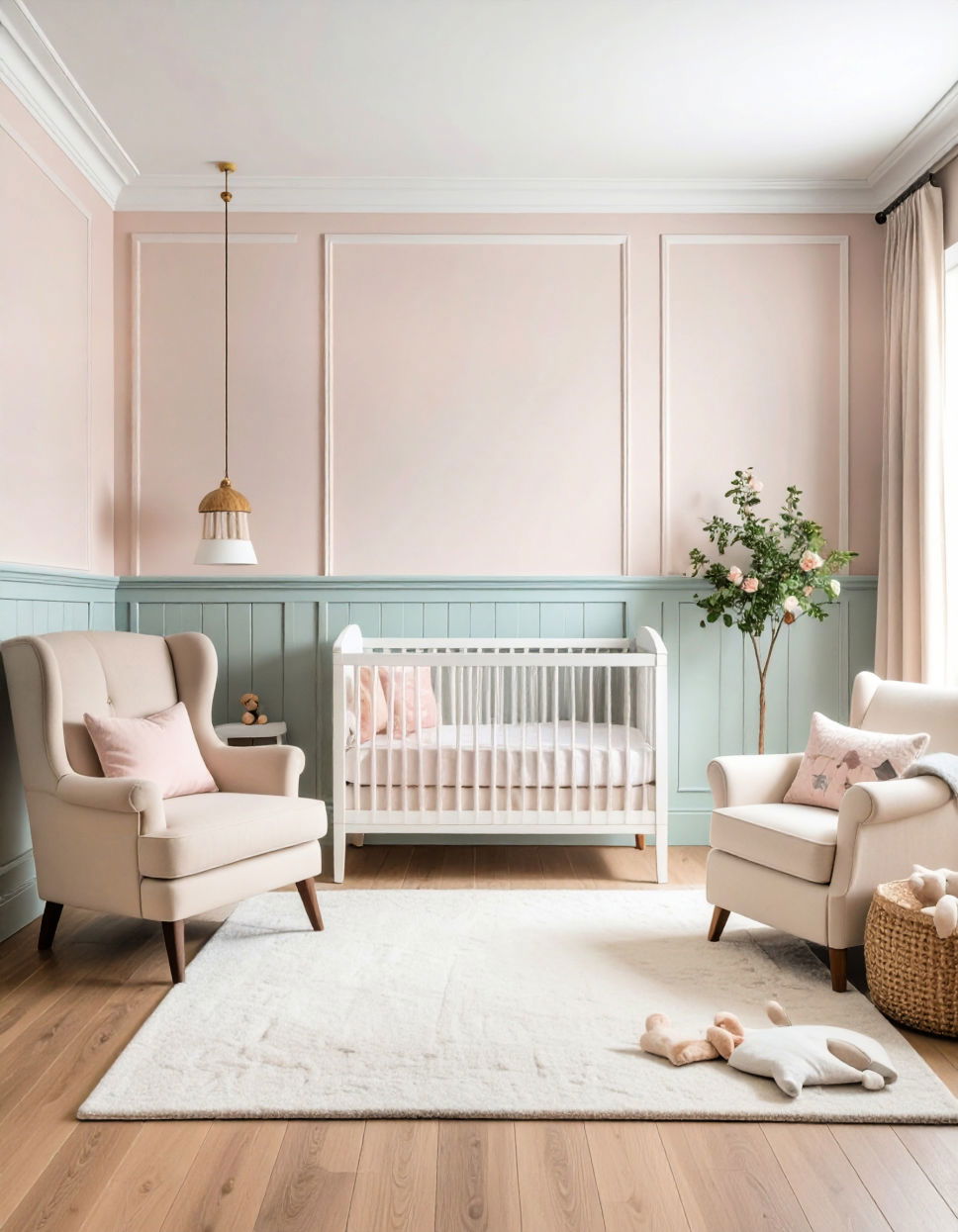
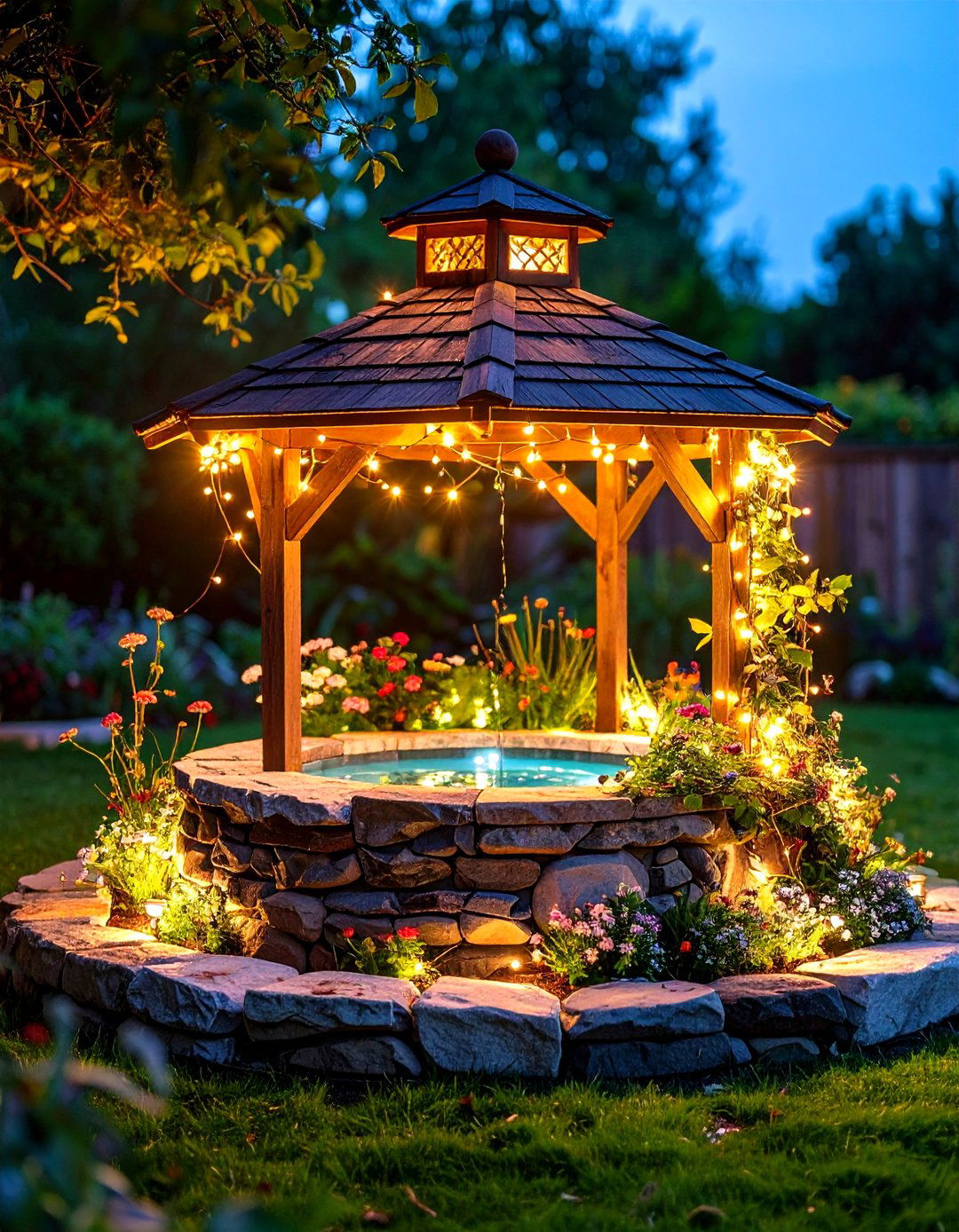


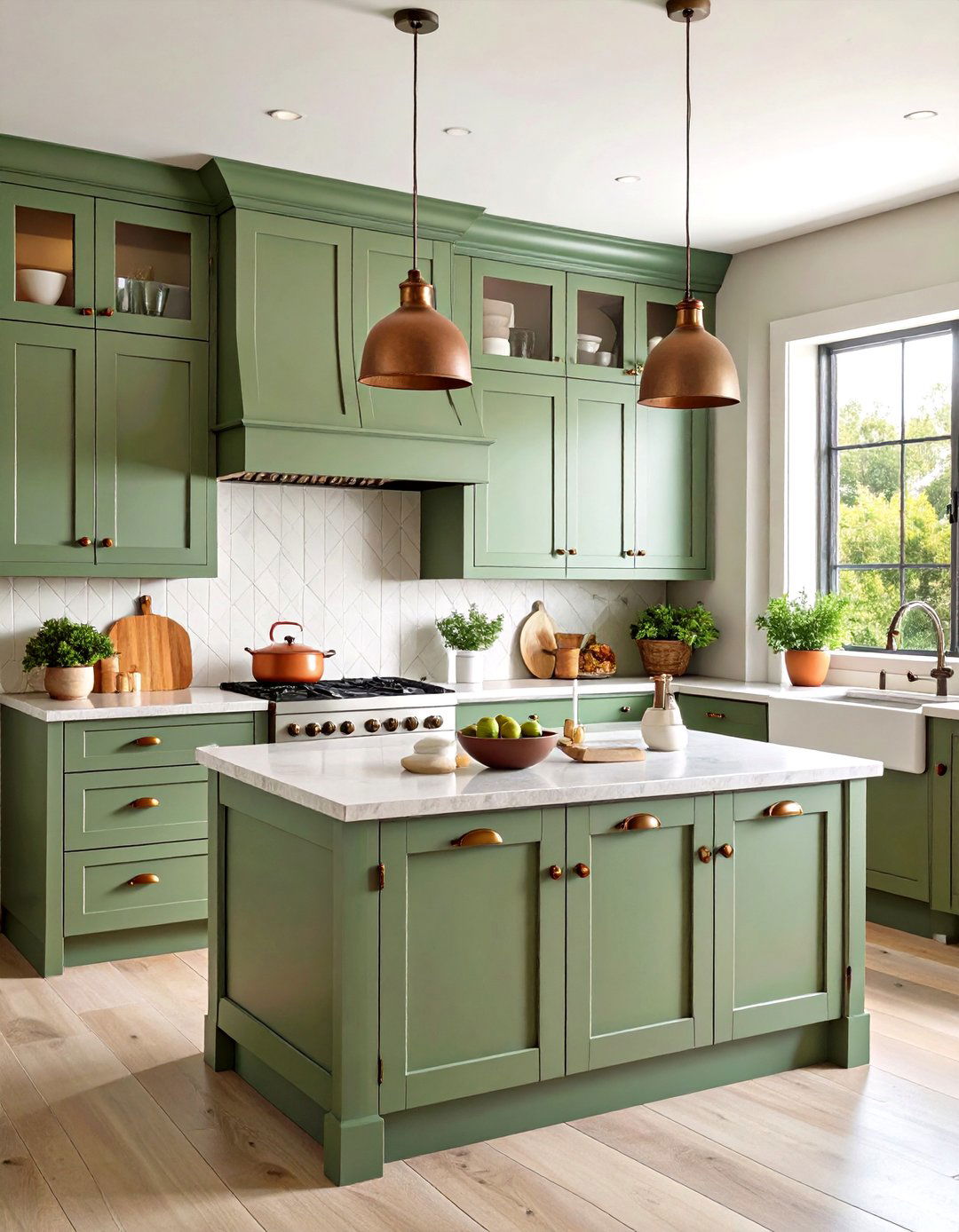
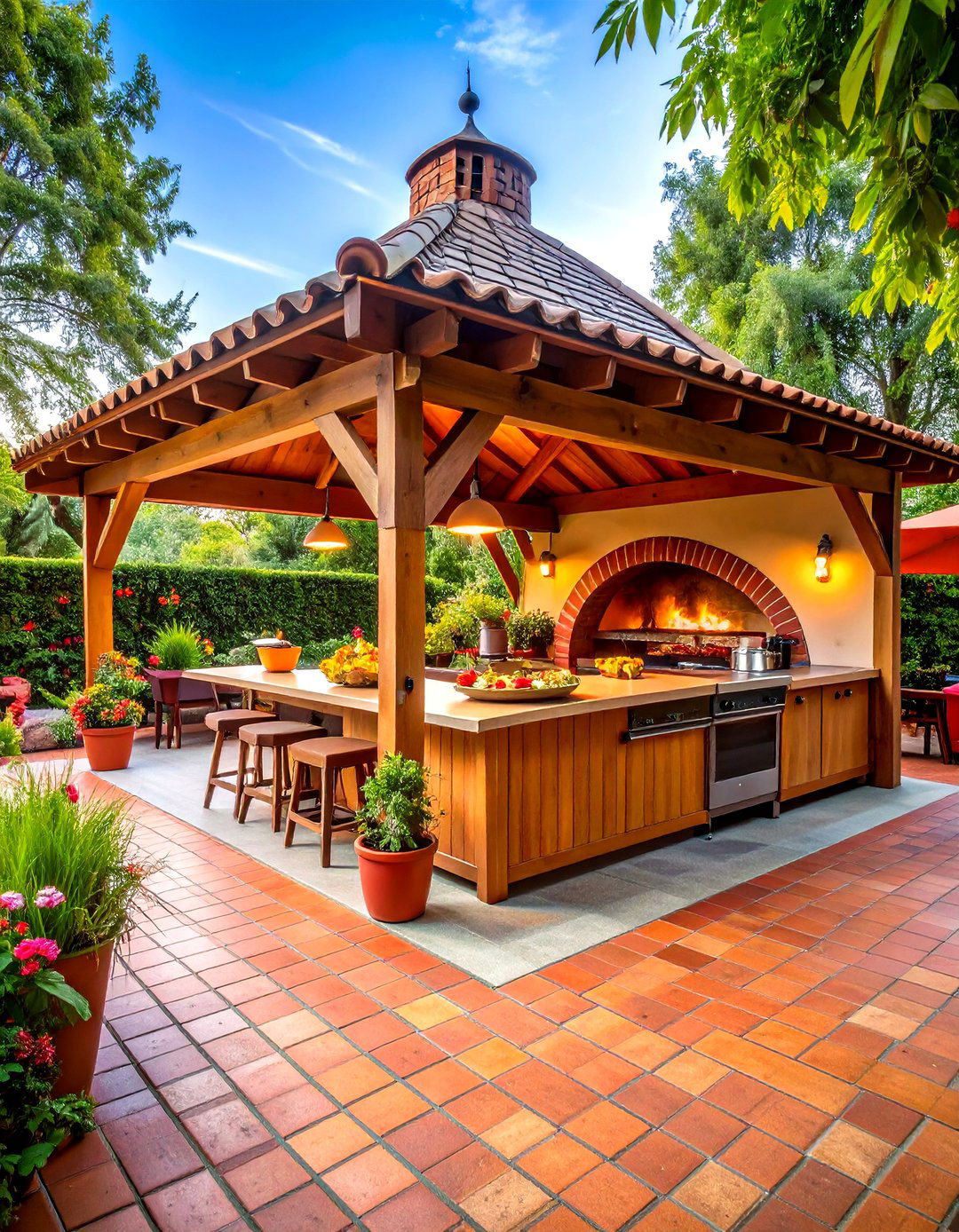
Leave a Reply